Posted in Nepal on November 2, 2023

Becky and I flew into Kathmandu from Delhi on Friday 27 October, arriving at 1240. We cleared immigration and customs without a problem and our bags also arrived on time, if a little slow. We were also carrying a box with 1000 “Diva Cups” to deliver to Creating Possibilities Nepal (CPN). As we went through customs, and the box was scanned, the agent asked us what was in the box. That generated a rather difficult and awkward conversation as Becky searched the net on her phone for a photo. We cut into the box and showed him one and he quickly said all was okay.
There was no one from the hotel waiting to collect us at the exit. So, after checking the line of drivers with signs several times and trying to call the hotel, I went to an ATM to withdraw some cash.
I got 10,000 Nepali Rupees (about $80 US) and we found a taxi driver who would take us to the Hotel Thamel Park for NRs1000. We arrived to the hotel quickly and we’re immediately impressed by how clean and quiet (compared to India) the streets were. Thamel was just as I remembered–the narrow streets, pedal rickshaws, shops, restaurants, trekking shops, etc.
At the hotel, they had trouble finding our reservation and we began to realize that the hotel was not running well administratively.
The manager, Shishir, greeted us and apologized for not having the driver at the airport to meet us. He claimed that he had confused the time, expected us to come in at 12:40 at night. As we checked plans for the others arriving later that night or the next day, we saw that it was a mess. Shishir had info on his laptop, but the front desk didn’t have the same info–they just had Joy Demsey ‘s name from DWC on all of the rooms.
I immediately decided to send notes to all of the others with instructions on how to get cash and a taxi to the hotel on their own.
Our room was large and comfortable, with plenty of electrical outlets and strong wifi.
We decided to go to the Buddha Stupa (aka Boudhanath) for the evening and catch the sunset, then return to Thamel.
The taxi was 700 NRs to the Stupa and 600 back. The area was fairly crowded, but peaceful and beautiful. We did two laps and took plenty of photos, then returned.
In Thamel, we had dinner at the New Orleans Cafe where we heard there was live music and good food.
They did have beer, but the food was fair at best. Becky had her first hamburger in two weeks and I had a paneer butter masala. The musician, a solo guitarist, was good, though the many patrons paid him little attention and were quite loud.
We returned to the room and went to bed early. The night was loud, with doors banging and people talking loudly in the hall.
The next morning, we enjoyed the large buffet breakfast spread and then met with Dinesh in the hotel lobby at 0800.
It was great to see Dinesh again! We told him that we would be touring in town that day.
Kyle Byard had arrived at 0200 that morning and had his own issues. His taxi took him to the wrong hotel and then transferred him to the Hotel Thamel Park by motorcycle. When he arrived, they had no record of a reservation in his name. That was finally worked out, even though (hours before) Shishir had assured me, via WhatsApp, that all was set for his arrival.
Saturday 28 October, 2023
Kyle met us at 0900 and we started walking towards Durbar Square in old Kathmandu, about one mile to our south.
About halfway into the walk, we found a Nepali clothing store with children’s sizes and spent about 30 minutes searching for and bargaining for the right hoodies for our four grandkids. The owner was very nice and allowed us to pay with a credit card at the shop next door. We deduced that he owned several of the businesses in this strip of sidewalk. He did try to talk on 4% credit card, but when we talked at that, he quickly relented.
We continued our walk to the Square and paid our 1000 NRs entry fee at the gate. Several freelance guides offered their services, but we declined. There were many Nepalis at the shrines praying and chanting, lighting incense stick, etc. I took photos while we walked around and oriented ourselves using the map.

We went first to the Kumari House, home of the most recently chosen nine-year-old “goddess,” but we’re not allowed in the line to view her since we aren’t Nepali.
We went to the main commercial square next in front of the colonial palace and museum area. Kyle was trying to coordinate his next-day’s helicopter flight into the Himalayas and begged off on our visit to Durbar Square to return to the hotel and speak directly with the helicopter company.
We continued on our tour, learning about Nepali history in the palace building and then touring the various temples and art galleries. Temperatures were moderate and the sky was fairly clear.
Around noon, we walked back to Thamel and stopped in a small, very clean and modern bakery named Pumpernickel for a coffee and snack. I ordered the yak cheese croissant sandwich and Becky had an omelet. Both of us ordered espresso drinks. Our waiter was a young man who spoke with a perfect American (West Coast) accent and we started up a conversation with him. He told us that his mom had sent him to university in the US (Seattle) and that he’d also worked in Michigan after completing his Computer Science degree. Now, he was back in Nepal working for his mother at the bakery. He gave us some good recommendations for dinner that evening and we talked in general about the busy trekking season in Nepal and how busy the bakery was this time of year.
We returned to the hotel and I left notes (WhatsAp andpaper, respectively) for Kyle and Joe Picton (who’d arrived mid-morning) that we would be going to the Garden of Dreams at 4:30 and then dinner at the (recommended) Dechenling Gardens Bhutanese and Tibetan restaurant near the garden.
Kyle met us in the lobby and we suspected that Joe was still sleeping so we departed a at 4:45pm.
We arrived at the garden and paid our entry fees, then relaxed on benches–while I took photos. It was a beautiful, calm evening with the sun setting and families and couples enjoying the evening, taking their own photos. I helped with a few groups and then met Kyle and Becky at the outdoor cafe for a drink before dinner.
By now the sun had set and the many crows and rooks flying among the trees had been replaced with large fruit bats, with about two-door wide wingspans.
From the cafe, we walked the short distance to the restaurant and we’re pleased to meet Joe there.
The food and service held up to our young Nepali friend’s recommendation and we all enjoyed it. I continued my veg streak with a bowl of vegetarian ‘meatballs’ in a Tibetan broth with coiled bread-like dumplings along with a Ghorka beer.
We walked back to the hotel as a team, but since it was early Becky and I went to the Skyz Bar at the top of the hotel for a nightcap and to monitor the arrival of Karen and Adam via WhatsApp. Afterwards, since it was still quite early, I also stepped outside by an ATM near the hotel for some cash and dropped by a shop to buy a couple of shirts or a hoodie for myself. I found a few that I liked, but had them set aside.
To end the day, I sent a note to all saying that I would lead an early morning hike the next day to the Monkey Temple, that it was optional for all except (jokingly) Adam, and that we would be leaving the hotel at 6:00 am.
Sunday 29 October, 2023
Adam was good at his word and in the lobby by 6. Karen sent a note saying she was on her way in five minutes and we departed just a few minutes after 6am.
Both Karen and Kyle seemed happy to get up early for hike, helping them to acclimate to the time zone. We used Google Maps to navigate and made it easily to the base of the stairs leading to the temple summit in just over 30 minutes.
The temple area was busy but not overly so. Many were performing their daily fitness rituals in addition to (or instead of) praying, chanting, and worshiping. The monkeys were everywhere–many more than I remembered–along with many dogs. Adam and Karen did well on the climb. Karen intends to do a 15-day trek to Everest Base Camp after our work project, so she was in good shape as well as happy to be getting in some climbing exercise.
Near the top, a huge herd of monkeys stampeded across the stairs from left to right and one jumped on Adam’s back in a very nonaggressive manner. Adam handled it calmly and allowed the monkey to ride for about 20 steps before it decided to hop off.
We spent about 20 minutes on the summit taking photos and watching the territorial interplay between the monkeys and dogs–each having their own distinct areas of dominance.
The light and haze made for beautiful photos. We’d made very good time on our climb, too, so we could leisurely stroll down the steps to the base. While doing so, though, another monkey jumped on Adam–this time atop his baseball cap. Again, Adam didn’t react. This smaller monkey rode for quite a while. Even the Nepalis on the trail were surprised to see this and several took photos.



At the base, we hailed a taxi. When asked, the driver said that a ride back to the hotel would be $10 US, to which I laughed out loud. I asked, “how much in Rupees?” and he responded with 1000 NRs (about $7.50). I offered him 400. We settled on 600 and we’re on our way, pulling up to the hotel before 7:30am–a great way to start our day. We went straight to breakfast and met the others there.
The next morning, Kyle departed for his helicopter ride and the rest of us met for breakfast. Both Adam and Karen had arrived the evening before without serious incident, but both had to arrange their own taxi as the hotel driver didn’t show again.
They both had had a good rest and we’re ready to join us for a 9am departure with a van arranged by Dinesh. We had Toyota Hi-Ace van a long with two young ladies from the CPN group home, Pushpah and Chadini.
We drove to Baktapur, about 40 minutes away. Along the way, we became acquainted with the girls, both of whom had been orphans rescued by CPN at ages two and four. They were now both 21 years old and in university, living almost all of their lives in the group home and now next door in the annex made for older teenagers and college students. They called Dinesh “Uncle” and told us about how they shared maintenance, cleaning, and cooking tasks at the house.
We arrived in Baktapur just before 10am, paid our entry fees, and then were found by a local guide, name Prashak, who seemed very “unpushy” and friendly. He said that he would give us a two- to three-hour tour of the area for only 1000 NRs – about $7.50 US.
Prashak was very helpful, informative, walked slowly, and helped us understand the town’s history. He explained that Baktapur was in the “Nawari” area of Nepal, and that the Nawari spoke a different language from Nepali. They dressed in black, red, and white, unlike some of the more colorful areas of Nepal. Baktapur was the original capital of Nepal, too, and one of the three original kingdoms of the Kathmandu Valley area. It is also the home of the tallest temple in Nepal.
We toured a Thanka painting school and learned of their religious/spiritual art forms and of paint and sand Mandalas or wheels and how some sand Mandalas would take weeks or months to complete. After completion, though, the sand Mandalas would be destroyed as the sand was not glued to the cotton canvas–just temporarily placed their.
We toured the pottery section and saw several potters and their kilns where they made terracotta and glazed cups, bowls, and pots. Some of the bowls were made with a very dark gray clay that seemed to be the preferred style of higher quality items.
Our guide left us just before noon and we walked another part of the city in a loop before settling in for lunch on the rooftop of the Golden Eyes Restaurant. We ordered set plates and momos–I had the latter, which were quite good. We had umbrellas for shade as the sun was quite warm. With the light breeze, it was quite pleasant.
After lunch, we walked back through the city and main square to our van and then departed for the Pashupatinath Temple complex near the Kathmandu airport–thr largest temple complex in Nepal, straddling the sacred Bagmati River.
Pashupatinath is also the site of Kathmandu’s main cremation center. Pushpah and Chadini led us to the banks of the Bagmati opposite the cremation platforms. They explained to us that the bodies would arrive at a main building to the north side, then would be washed with the waters of the Bagmati on stone ramps before being moved to one of ten steel-canopied platforms.
You could not make out any of the bodies from our location as they were covered with logs of wood and garlands of marigolds. The girls told us (something we’d heard in Varanasi, India as well) that the sons of the deceased were responsible for carrying the body to cremation site and attending the event. Family were dressed in all white and would fast for 12 days following the death of a loved one, avoiding things like salt and sugar, in particular.
While we were there, a half-dozen cremation fires were blazing at some level. One platform was being cleaned with buckets of water, steam forming as the water was dumped into the still hot iron cremation platform.
One large family group was carrying a covered body to a freshly decorated platform, preparing it for cremation. The total group seemed unusually large compared to the others, with what looked like 100 in the procession.
We walked around the ground of the temple, taking photos and listening to our young guides describe the area. The main inner temple area was not accessible to non-Hindus, but we’re able to see some of it from an overlook on the north side.
After viewing the temples, pyres, and people, we walked back to the parking area and our van. Once arrived, we communicated with Dinesh and arranged for a return to the hotel to pick up Kyle, as well as a 90 minute relax and refresh period before leaving for the CPN group home for dinner at 4:30.
On the way back, I realized that I had probably left one of my debit cards in the ATM the evening before. Becky used her phone to put a freeze on the card as I tried to retrace my steps. When we returned to the hotel, I walked to the ATM kiosk to check for my card on the off chance that someone had just found it and left it there.
When I arrived, I was surprised to see a young lady sitting on a stool in the back of the kiosk area–where there were ATMs for four different banks. I asked her is she had found a left-behind card. She acknowledged me, reached behind her into a cupboard cabinet above her head and handed me my Entire Federal Credit Union debit card!
I returned to our room and relaxed for a while. House cleaning had, again, not visited our room, so I was sent to the lobby to get fresh towels and additional toilet paper. On the way down the stairs, I saw the cleaning crew on the fourth floor (our room was on the sixth of eight floors), sitting on the floor checking their cell phones. I told the Lobby desk that the cleaning crew needs not visit our room.
I returned to the room and Becky and I concentrated on repacking our bags for the next day’s departure for Lamahi. We separated the things we wouldn’t need there into our duffel and another bag that we would leave behind in the hotel and consolidated our work items into two bags we would check for the next day’s flight.
At 4:30, we joined Pushpah and Chadini in the lobby and walked about 400 meters (with several busy road crossings) to meet our van at a curb in the rush hour traffic.we ride about 20 minutes to the CPN group home where we witnessed our drive skillfully back the van into the gated driveway of the home from the unusually narrow alley entrance, accomplishing the feet in five stops or “J’s”.
The CPN home is quite the colorful and well-kept oasis on a hill in the city. We were seated in the living room area where Dinesh described the background behind CPN, its establishment, founding donors, and the relationship it had with several Nepali, regional, and international charity organizations (NGOs). He introduced us to Michelle, a 70ish Canadian woman who had worked in Nepal off-and-on for over 20 years, working for and establishing some of the NGOs that supported CPN, primarily from Canada and the US. Her story of travel and involvement in issues important to women and forced/indentured labor in Nepal wer inspiring as well as reassuring. It confirmed our sense that DWC and CPN were working effectively and accountably to help solve problems throughout the country.
Dinesh explained to us that Michelle would be traveling with us to Lamahi, but working in Gadhwa at the CPN site there on other projects besides our home building. Michelle told us, when I asked about whether she’d considered writing a book about her experiences, that she had. She told us that she had an editor and had been shopping it around, having received two declinations so far, but that she was not giving up.
At about 7:00pm, we departed the CPN house and returned to the Hotel Thamel Park. Even though it was quite early, everyone went to their rooms to prep for the next day’s travel.
Monday 30 October, 2023
Our alarm went off at 6:00 and we rechecked our packing and fired up my laptop to continue uploading both India and Nepal photos to Google Photos shared albums. The Hotel Thamel Park had excellent wifi and I was finally catching up, loading more than 2,000 photos in the previous 36 hours.
Breakfast was good, as usual, and the whole team was there to eat before 7am. We talked about the day’s plans as well as howu h we’d learned the day before. Adam had been a huge hit with the young ladies who had peppered him with questions all day on Sunday and into the evening at the CPN house.
We decided to leave two bags behind, checked at the registration desk: a duffel filled with our many fabric souvenirs and a roller bag of clothes and shoes we wouldn’t need. I also settled our hotel charges for breakfast cappuccinos, top floor drinks, and laundry totalling about $30US.
We left promptly at 8am and drove to the CPN house with the same driver and van, arriving at 8:20 to pickup Michelle and Dinesh and drop Karen’s bag of trekking clothes and equipment for safe-keeping. She would be meeting her trekking group on the Friday of our return and departing with them the next morning, so that made sense. She didn’t have time or margin to worry about our process-challenges hotel misplacing her things.
We next went to the airport and rolled our bags to the Buddha Air check-in. Dinesh took our passports and returned with our boarding passes. We cleared security without any problems and we’re in the new domestic terminal area before 9amnfor our 10am departure. I used the time to write.
We boarded a rickety airline bus at the gate that transported us to the far north end of the tarmac where we boarded our Buddha Air ATR 72-500 from the rear entry.
The plane departed on time, was mostly full, and was very smooth. We landed at the single domestic terminal for Gautama Buggha International Airport. We descended the stairs from the plane, walked across the tarmac to “arrivals” and waited at the single concrete counter for the baggage haulers to push the cart with our bags into the bay on the opposite side. From there, Dinesh helped us match bag tags to claim receipts and the handlers have us our bags.
We immediately noticed that it was about 10 degrees Fahrenheit (6C) warmer than in Kathmandu and very humid in the hazy sunshine. Dinesh told us that we would drive about 40 minutes to the Buddha Temples at Lumbini and spend some time touring the area before lunch.
After stopping to use a wash room and buy tickets we went to the main temple area with it’s huge moat surrounding the supposed birthplace of Buddha, with brick village ruins dating to the first century BCE through the third century CE. A large white temple encased more ruins and the declared footstep of the bodhisattva himself. A short line led to the viewing point for the footstep–something I’d seen in my 2019 visit.
We met outside and walked around the complex and then back to our shoe station since we’d had to remove our shoes during the entire time we were in the fenced temple area enclosure.
From here we walked back to the vehicles and visited two more temples in the area, built by the Thai and Cambodia governments. It seemed that every Asian nation with a majority or large Buddhist population has a temple or monastery in the complex including Myanmar, Vietnam, Korea, China, India, and Japan (in addition to the two mentioned above.
By now, we were fairly tired and sweaty and left for the Pauwal Restaurant about 45 minutes drive closer to Lamahi. Dinesh took our orders from a few choices and called ahead to make sure our food would be ready upon arrival.
The food wasn’t ready. Not even close. We ordered soft drinks and water and waited. I used to time to complete our team meeting and talk about policies, rules, and suggestions for our time in Lamahi. All seemed very much in agreement and enthusiastic about getting started, so that meeting went well. I didn’t anticipate any problems.
Karen’s fried rice came out with the color and distinct aroma of something containing soy sauce–something she (through Dinesh) had said she could not eat due to her gluten sensitivity. Dinesh was clearly disappointed that the food took so long to arrive and that his directions had not been followed. Nonetheless, we paid for the food, finally departing just before 3pm to begin the final phase of our journey to the Classic Hotel in Lamahi.
The drive was much as I had remembered it from 2019 with seemingly endless fields of rice ripening or being harvested. Farmers were in the fields cutting the rice by hand, tying bunches together in conical form that would then be hauled to threshing sitea by others. Large tarps alongside the road were covered inches deep in drying rice. Huge piles of chaff surrounded homes and barns. The amount of manual labor being done to affect the harvest was astounding.
We crossed one mountain pass before getting to the river valley where Lamahi is located. There were signs of dozens of mud slides from the rainy season that had partially or fully covered the road, many damaging culverts, barriers, and the road itself. Passing large trucks in the winding roads as more than a little sporty, but our driver did well.
We arrived at the Classic Hotel and Lamahi at 5pm and checked in. The manager, Dharma, remembered me from four years earlier and was obviously pleased to see us. Dinesh had related to me how difficult the pandemic has been on them, going months without any business or income. It was obvious, though, that they’d made some upgrades with the lobby being much more organized and modern. They now had three refrigerators with soft drinks, beer, and cider and the main desk looked new.
Dhaa showed us to our rooms, all on the first floor above the lobby except for Joe who was on the second floor.
Our room had a single queen-sized bed, small sofa and three electrical outlets. The wifi seemed to work well and the room was very clean. The bathroom was still very basic with the shower not separated from the sink and toilet area by any curtain, glass, or doors.
Becky and I organized our baggage and clothes and then I went downstairs to get a list of rooms from Dharma as well as his number for WhatsApp communication. I forwarded this info to the others electronically and by paper to Joe, then returned to the room to load more photos, manage receipts, and record some transactions.
We met at 7:30pm for dinner and eat of us received a Thai plate with dal bhat (yellow lentils), rice, greens, french fries, potatoes, spiced chicken chunks, and a few picked garnishes and sauces. Dharma brought seconds to those that requested them and we all ordered either beer, cider (Karen), Coke (Kyle), or water. The food was much as I remembered and quite satisfying.
We were in our rooms by 9pm. Becky and I slept reasonably well, though she got up once during the night to change the air conditioning thermostat from 20C up to 22 C (68F to about 72F).
Tuesday 31 October, 2023
We got up at 6:30 and discovered that the toilet bowl was not refilling. I tried to fix it, but couldn’t find the issue. I used the bidet hose beside the toilet to fill the bowl so that it would flush. I later learned that Adam had faced the same issue next door and used the same solution. I alerted Dharma to the problem and he allowed us to use the bathroom in 103 and promised to have the problem fixed while we were away working today.
Breakfast good with small omelets, a little bowl of curd, toast, and fresh fruit. Dharma also brought us black and milk coffees made with Nescafe. We talked through breakfast, mainly regaled by Kyle’s and Adam’s harrowing stories of growing up in New Jersey and their experiences with a certain notorious theme park called “Action Park.” This park had apparently been the subject of.a documentary entitled “Class Action Park,” for the many injuries and deaths that had occurred there over the years.
The day started cool, foggy, and hazy. Dinesh said that transportation wasn’t coming until 9am, so we relaxed, reorganized our equipment, and chatted about the day. Karen, Becky and I were decked out in DWC gear. We filled our water bottles and waited for the VA or bus.
The van/his turned into two tuc-tuc instead. We put three in each and drive through Lamahi to Gadhawa. The road construction that I’d seen in 2019 southeast of town was complete, but one bridge over a stream was washed out. Instead of fixing the bridge, the highway department had just put in a large concrete pipe and then graded earth over and around it to make a very slow, rutted “road.”. There was no indication that any repair work was being done, not that the bridge would be replaced any time soon.
After clearing the washed out bridge, the road was smooth until we turned left in Gadhawa towards CPN’s Unako House facility.bfrom this point, it was very poor dirt road and a bone-jarring bridge.
We arrived at 9:30 and went upstairs. Almost immediately, I saw Henraj and Shyam with whom we’d worked on our last trip. I recognized many others, but couldn’t remember their names.
There were about a dozen women there who next made a presentation of marigold leis for each of us, thanking us over and over again for coming (or returning) to Unako House for more work.
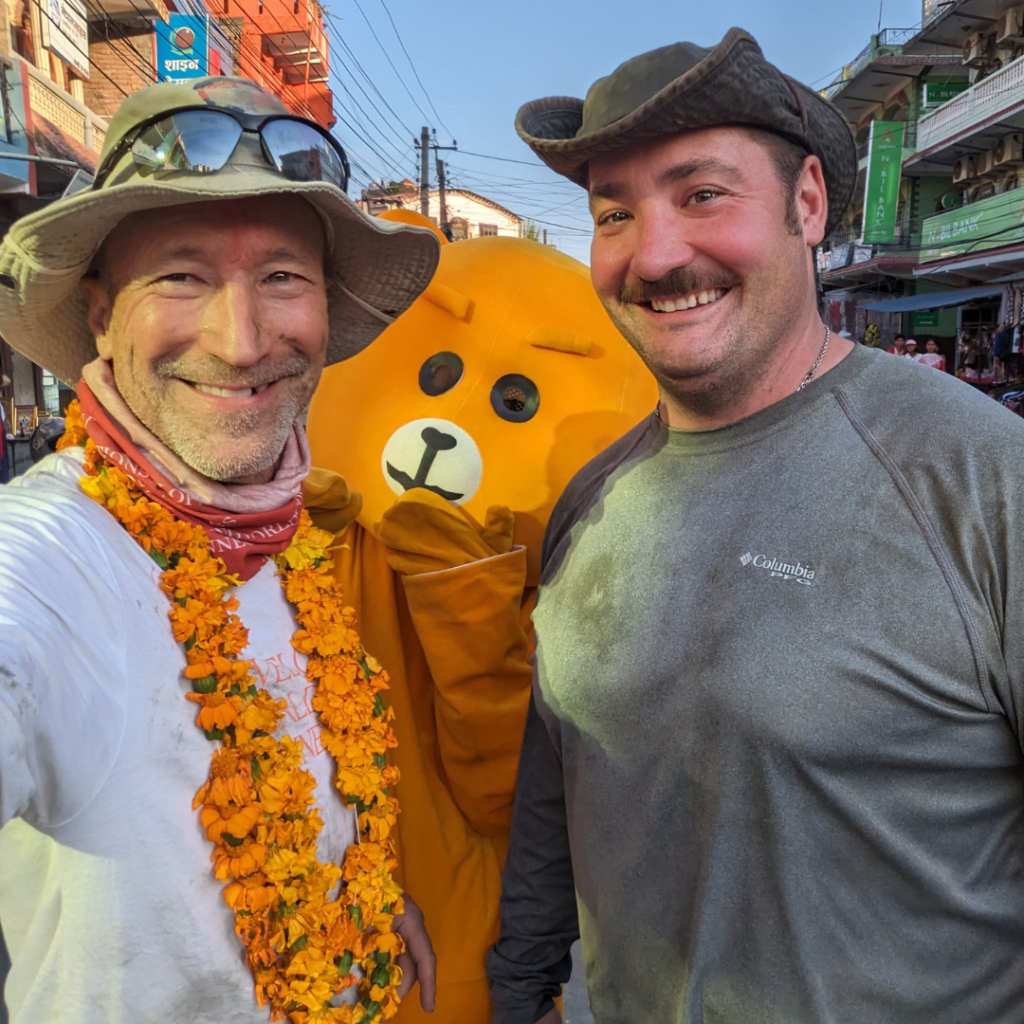
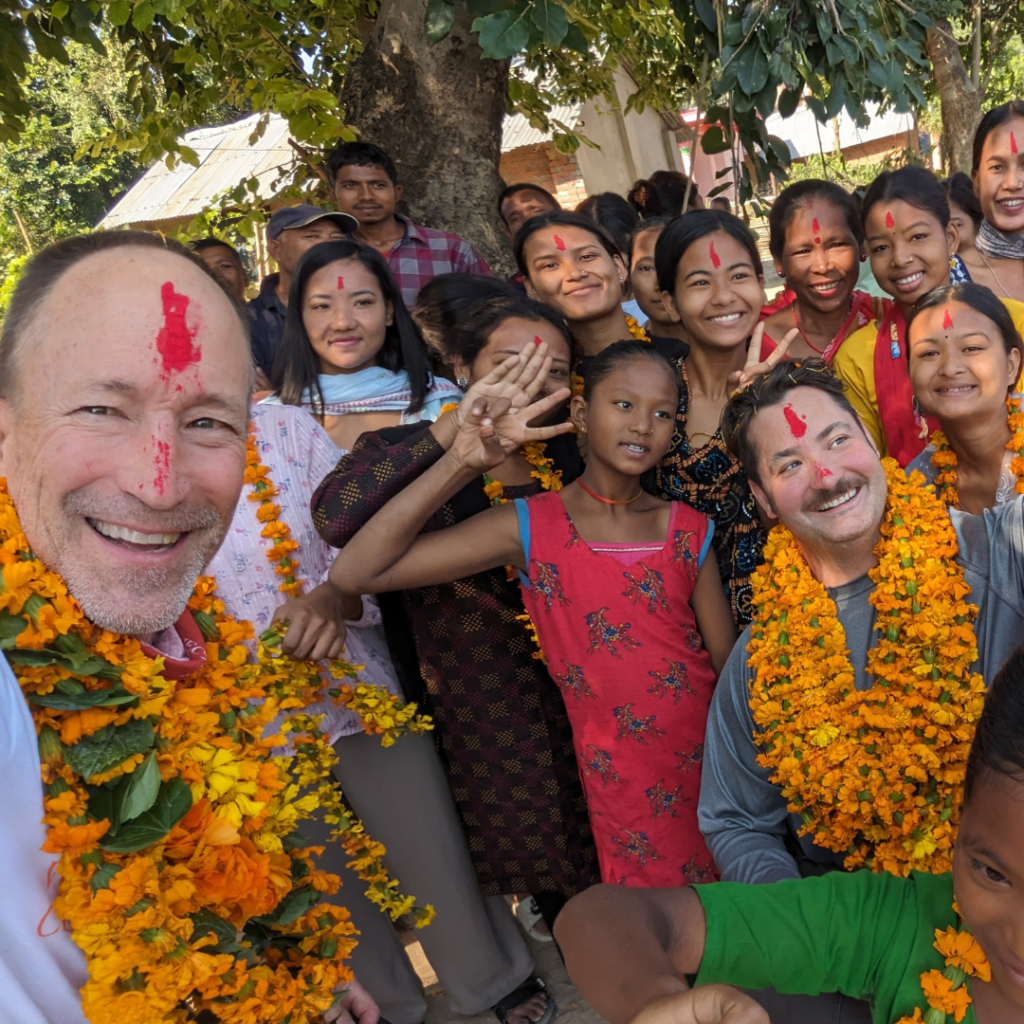

We took some photos and then jumped into our tuc-tuc to go to the work site, about 10 minutes away.
When we arrived at the work site, we found chairs set up in a semicircle and at least 50 people waiting to greet us. Dinesh introduced us to the lead woman of the local Mothers’ Group, our work foreman, and two young ladies, Ria and Chita, who would serve as our interpreters. There presentations of more marigold leis, more tika blessings and thanks, and then we met Sunita and her father–the two ultimate beneficiaries of our work who had been identified by the Mothers’ nGroup based on their need.
Again, we took more photos and lots of selfies with the kids, then walked next door to see the project. To say we were overwhelmed by the greeting was an understatement.
At the site, we could see that the foundation trenches had been dug. They made a rectangle about four meters by eight meters on the outside, with each trench about one foot deep and 18 inches wide there were two interior trench cut across the rectangle as well, parallel to each other, centered and about one meter apart .
We were pleased to see that,nat least until noon, most of our work would be done in the shade of an adjacent home and a large tree. To the east of the foundation, we saw two large piles of white river rock (4″-12″), and to the west were two large piles made up of several tons of aggregate gravel and sand for concrete and mortar. There was also an odd pile of red bricks in a circle next to the site that looked like they had, at one time, been part of some conical temple or structure of some sort. Much of the dirt from the excavation was piled into the middle of the construction site in the area that would be two of the house’s three rooms.
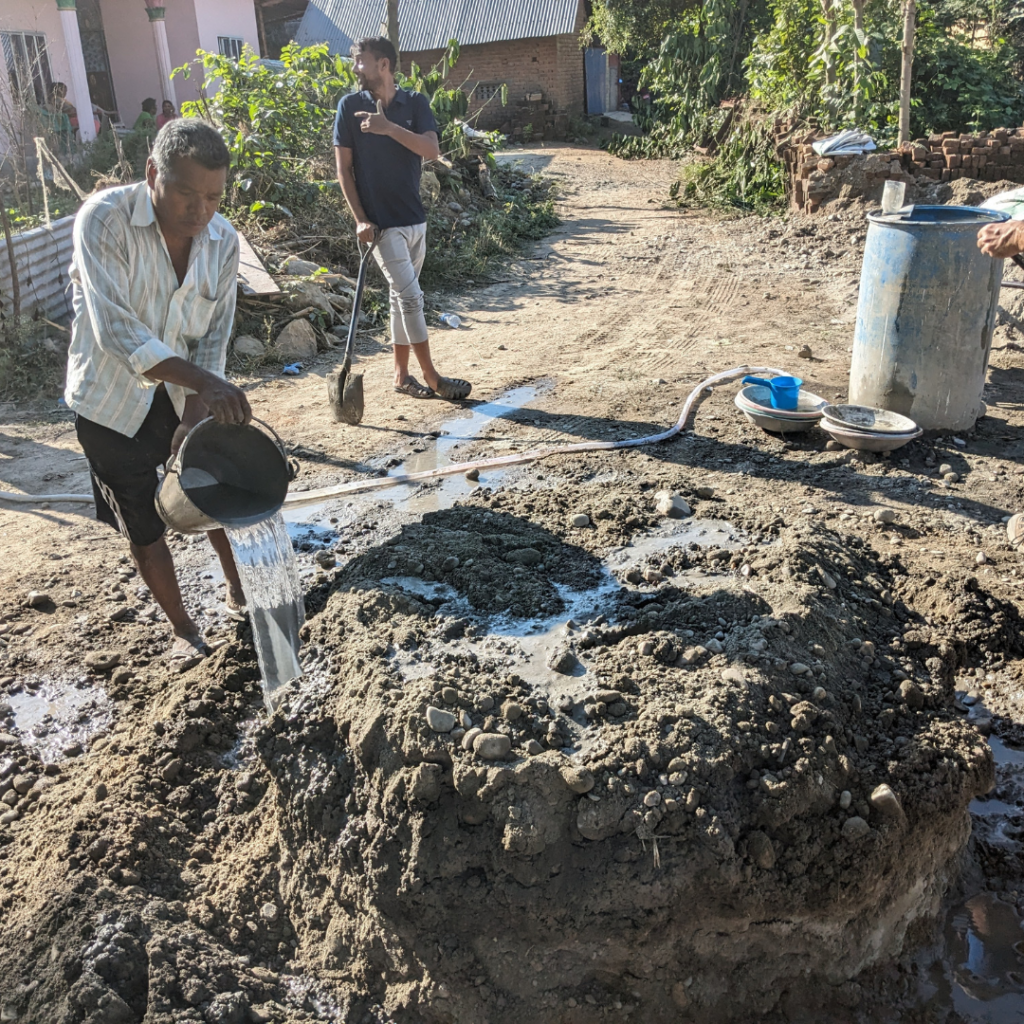
Our first task was to finish the foundation trenches by sharpening the edges of the trenches and removing excess dirt. We did this with shovels and hoes under the direction of Shyam and our foreman. While that was being done, river rock was being placed one rock high in the acceptable areas of the trench and then carefully placed so that they were all touching adjacent rocks at several spots. The local women helped with all of this.
Our next task was to mix concrete. We were directed to the aggregate pile and told to move 16 level wheel-barrows full of aggregate to a spot just south of the foundation and then add four 40kg bags of cement and mix. We all started work on this while the local ladies and others helped finish the river rock placement.
We only had one wheelbarrow and about a half-dozen shovels for the work, so we too turns with the shoveling. Adam did most of the wheelbarrow movement. We made quick work of the large pile and our foreman and others began mixing the pile after carefully untying the cement bags at their seams, presumably to preserve the bags for reuse.
Next came the dry mixing. We all worked together on this, employing the same method I’d seen in several countries–moving the entire pile one to two meters away, one shovel full at a time, turning over as mixing as we moved. Once the pile was partially mixed and moved, we would repeat the procedure and move it back to its original position near the foundation trench. I would estimate the entire pile was about two tons.
Everyone helped with the mixing, including the locals. One woman with a white head scarf/bandana stood out as particularly strong, tirelessly turning over dry concrete mix and moving around the pile.
After the second pile move and mix, we shaped the large pile into the usual volcano shape and then added water from a large hose into the “crater.” Then, we moved around the volcano with our shovels scooping dry mix into the crater at its edges to slowly wet all of the mix. This is the same game we’d done in Costa Rica, Kenya, Cambodia, and Nepal before where this process continues until someone breaks the dam-like crater edge and mix comes spilling out or the breach is mended with other shovel loads of dry aggregate and the mixing continues.
This was the largest pile of concrete that I had ever seen mixed by hand on the ground, probably by a factor of two. However, so many people were working on the mix that it progressed very quickly. We shoveled the mixed concrete directly into foundation trenches while the local women used large plastic and steel tubs to move the concrete to the other sides, often by placing the tubs on the heads. One woman was so adept at this that she could lift the 15-20 kg load atop her head onto a small fabric donut pad and then walk over without her hands balancing the tub.
The first large load completed almost three-quarters of the first layer of the foundation, covering the rocks rocks, but not much more. The foreman and one of his assistants troweled the concrete level and directed the porters.
Once the pile was scraped down to the ground level, we repeated the process with half as much mix: two bags of concrete and eight wheelbarrow loads of aggregate.
I was amazed at how fast all of this went, the speed of the work attributed largely to the number of locals that were helping us, Before we knew it, it was noon and we did a light clean-up and went to lunch back at Unako House via tuc-tuc.
Lunch consisted of a delicious potato and greens dish lightly spiced with some turmeric and salt as well as a rice and coconut pudding that everyone enjoyed. We had cold Coca Cola and bananas as well. Michelle told us that the pudding had take the local ladies all morning to prepare.
After relaxing a few more minutes and visiting the washrooms, we returned to the work site again via tuc tuc. The afternoon was much less physically demanding, which was a good thing because now we were in direct sunlight. The first layer of the foundation was mostly set and we started to assemble steel plate frames for what we assumed would be more concrete pours in layers to complete the foundation. The form plates were 18”x36”. They were wired together by the foreman and his assistant after we’d moved them into place. Their initial pile of forms was insufficient, so Adam was sent by motorcycle to get more. He returned via a tuc-tuc transport with as truck bed rear about 20 minutes later with another large load of plates.
The process of placing the plates and locking them together was tedious. There were no good stakes to mark the position of the plates well, nor were there wooden braces to hold them in place. Scraps of bamboo and branches were used and the measurements made and lines run between stakes seemed far from accurate or stable for that matter. Some of the trench foundation gaps were set at 12 inches, while others looked to be closer to 18 inches, too.
It also became clear that they needed more plates to complete the work. Since Adam wasn’t sent to get more, though, we went to work moving more river rock into place for work the next day. It became clear that we would be placing the river rock in the same manner as earlier in the day to form a second foundation later and that that would be done the next day. We also suspected that that would not be the final layer of concrete and that we would be mixing and pouring (and placing river rock) until we had filled the trenches to the tops of the forms. I suspected that would take two or even three more later of rock and concrete. Adama confirmed that thought by reporting that he saw at least 20 more bags of cement in the storage area.
Just before 4pm, we decided to break for the day, leaving behind the foreman and a few of his helpers to continue work on the frame plates–work for which our help was not requested except to move the plates into rough position, which we had already done.
As the day wound down, Joe (who was a favorite with the kids that were spectators most of the day) walked next door to a large rice straw pile and watched as the kids performed some gymnastics moves on the soft padding. One boy could do full back flips, while others did somersaults and handsprings. Joe elicited cheers of joy from all of them as he did a soft roll.
We returned to the hotel by about 4:30pm and Adam, Joe, and Karen joined me for a walk into town. Still in our work clothes with marigold leis around my neck from the work site, we attracted a lot of friendly attention in town, walking about a mile from the hotel, spotting ATMs we might use later and surveying the markets, shops, and citizens of the town. I thought that it looked cleaner and more prosperous than my visit in 2019, with several shiny new buildings, nicer cars, more bicycles and less trash on the street.
We walked back to the hotel in the setting sun, past a herd of goats on the street as well as several cattle. On arrival, we declared Happy Hour and Adam treated Karen to a cider and me to a Gorkha Premium. We discuss the day’s events as well as world politics, each other’s backgrounds, and the overall state of our project, DWC, and CPN. We then returned to our rooms and cleaned up to prep for dinner, coming downstairs at about 7pm to agin sit outside with the others, chat in the cool evening air and plan for the next day.
Dinner was largely the same Thali plate as the night before, with extra “seconds” brought by Dharma. The cauliflower was very good and most asked for seconds of one item or another. We were all tired, though, and went upstairs to our rooms by 8:30
Wednesday 1 November, 2023

Everyone was in good spirits in the morning and all were downstairs before breakfast for coffee. Joe had completed his morning yoga on the roof and Adam dropped off laundry. I’d spent most of my early time catching up with this blog. Karen handsome stuff shoulders and my lower back needed some stretching.
Breakfast was the same omelet, banana, toast, curd, and sliced apple as before. We anticipated an 8:30 tuc-tuc pickup and talked over breakfast about the day’s plan, completing the foundation framing, mixing more concrete, setting river rock, etc. We all hoped to get two layers of foundation complete today, but realized that all would be fairly fluid.
I loaded a few photos into Facebook while Becky sent videos and photos to all via WhatsApp. We sent notes and answered questions from friends back home who were still enjoying their Halloween 11 hours and 45 minutes earlier in Colorado.
We drove directly to the work site this morning and found Sunil, our foreman, and his assistant working on the forms for the foundation. More had been delivered and they seemed to have enough to complete the job. They used chucks of old boards and anything they could salvage to fill in gaps between the forms, then used a combination of wire, sticks, and large stones to hold everything roughly in place. We helped a little where we could, but there wasn’t much to do but watch.
That all changed at 9am when a dump truck arrived with a delivery of several tons of aggregate. It dumped it’s load right beside the house foundation and some of the gravel pushed in one of the sides of the forms–something we quickly fixed. Our next step, according to Hemraj, was to bring in 1o 50 kg bags of cement to mix with this huge load. This would be 2.5 times bigger than the day before’s historic pile.
We did as requested and carefully untied the bags to preserve them for future and other uses as before, the emptied them onto the pile at various points. The pile was just too big to mix in one spot, though, so we split it into two piles and worked on them one at a time,
One good thing about the piles being so big was that we could get plenty of people around the piles for mixing. By now the locals had arrived, including many teenagers. The teenage boys got involved with the mixing when they saw that the teenage girls were there. Feats of strength ensued and the work went quickly. Again, we were happy to be in the shade.
The water hose was next brought in for pile number one and the wet mixing commenced. While we were doing this, the local ladies continued their work from the day before by positioning large white river rocks around the outside and on the inside of the frames. We also leveled the dirt mounds on the inside of the frames, essentially leveling the floors of the home.
Once the concrete was mixed, we started passing tubs of the mix to Sunil and his assistant, dumping them in the trenches starting at the far corner. Before long, a fire brigade-style passing line was set up and the work moved very quickly given the volume. The larger locals and we set up on the outside passing the tubs to be dumped, while the smaller kids formed their own line on the inside passing back the empties We had two or three shovelers filling the tubs and one or two people on their knees in the concrete passing the single-shovel-full tubs to the first person in the chain, Everyone got into the exercise quickly and enjoyed it. We made huge progress amid the flurry of constant motion.



Before we knew it, the first half of the load was in the trenches, Sunil was troweling smooth the tops of the trenches (just about an inch below the top, and we moved to the second “half pile” for mixing. As the concrete was being added to the trenches, Sunil, his assistant, and the local ladies were tossing in large river rock as additional fill. There seemed to be no real pattern to this other than to fill space–which we appreciated.
We wanted to get the second pile done before lunch and did exactly that with the help of all of the kids and local women. Hemraj explained to us that the kids were free from school because of the Diwali season holidays, so we could count on them being there every day. Sunita’s father was also a big help. The second pile mix went well and we did, indeed, complete the second pile by about 12:30pm, after which we went by tuc-tuc to lunch.
For lunch we had ramen-style soup with some bland, large, long rice paste tubes that Michelle said were well-loved by the locals and only prepared during festival season. They had virtually no taste. Before we ate, though, we all had cold Coca Cola again, happy for the caffeine and sugar. There was plenty of water as well, and Dinesh asked for some bananas. We all agreed that the work this morning was even harder than the day before and we knew we faced more work in the afternoon.
We were back to the worksite by about 1:30pm. Our instructions this time was to move 25 wheelbarrow loads of aggregate to the mixing spot along with five bags on concrete. Now, we were working in the afternoon sun and it was significantly hotter.
The work progressed much as it did in the morning, though we no longer had the teenage boys. The women of the village continued to work amazingly hard. We worked hard, too realizing that we really just had this work to do before the day was complete.
The work was done by just before 4pm, so we cleaned up and relaxed while Hemraj called the tuc-tucs. Joe continued to delight the children with his games and they enjoyed the break to take selfies with us, learn hand-slapping rhythm games, new English words, and asking us questions.
We left just after 4pm and were back to the hotel before 5pm. Everyone was exhausted, We’d planned another walk into town, but we just sat in front of the hotel had enjoyed cold coke, beer, cider, and water–in all of our filth and grime,
Kyle asked if we could move dinner up to 6:30pm and Dharma said that it would be no problem. We then broke up to go to our rooms for showers and cleaning.
Dinner was much the same at 6:30 with some more chicken. Four of us decided to stay a little longer to play cards, so Joe and Adam played a round of “Oh Hell” with us. During this time, Dharma and his family had dinner in the lobby. We all went to our rooms for bed just after 8pm.
Thursday 2 November, 2023

Most of the team was in the lobby for coffee and breakfast shortly after 7pm. Joe was completing his yoga upstairs and Kyle, Karen, and Adam were seated outside enjoying the sunrise–though the air was again thick with smoke and somewhat foggy.
We ordered our coffees and Dharma returned with them quickly. I dropped off more laundry, committed to using their service every day as another means of supporting their business, which the team agreed was a good idea. Breakfast was generally the same. This morning we had peeled orange slices instead of apple. Dharma was generous with the bananas.
We stopped on the way to work at a pharmacy where Joe bought some electrolyte mixture to put in his water. I also bought some generic Dulcolax for a bit of on-going “stoppage.”
When we arrived at the worksite, Sunil and his helper were already there and we were also greeted by another large pile of aggregate for concrete. We set to work almost immediately, separating the pile into halves and adding five bags of Portland cement to the first. The mixing began and as we got close to it being ready, the locals arrived to help with the first brigade to complete the foundation.
The first pile was followed by the second pile that was, itself, broken up into a smaller pile first. That clearly (to us, at least) wasn’t going to complete the work, but we did it anyway, and then mixed some more until the job was done.
Now that our foundation was done, we worked on two more things. First, the foundation forms were removed from the north room walls and the earth was leveled in that area. While this was happening, the white river rocks were ALL moved from the east to the west side of the house using a combination of local fire brigade, carried tubs, and wheelbarrows. The kids really liked it when Joe and I “beeped” like a tuk-tuk as we moved the wheelbarrows.
During the rock moving, we had our first treatable injury when Karen got a finger pinched between two of the larger rocks. It looked very painful and bled some. As she pointed out, it was clear that she was going to lose her fingernail. I found the first aid kit and she wiped it down with an alcohol pad to clean the wound and then put on a bandaid, then went back to work as if nothing had happened–though we could tell it hurt quite a bit.
After this was complete, Dinesh took us on a walk around this part of the village of Gadhwa. We saw the storage shack that was the sleeping location for Sunita and her father as well as the other homes in the village. There seemed to be quite a disparate level of income here with a couple of nicer, multi-level homes painted in bright colors next to mud and stick homes with thatched roofs. We saw one family reapplying a fresh coat of mud to the exterior of their home.
Pottery seemed to be a staple product of this part of the village, too, with many pots drying or stored near homes, all in a standard pattern and red-brown in color with some simple black or dark gray decorative symbols.
From here we went to lunch and had chicken in broth with smashed, dried rice, and some potatoes. It was good as usual, accompanied by plenty of water and cold Coke. Walking around the Unako House after lunch, and just prior to loading into our tuk-tuks, I noticed a special needs young man whom we had befriended on our last trip. He seemed to be healthy and doing well and acted like he remembered me. He had followed us, and in particular Mike Van Valkenberg, almost everywhere we went. On our last day in 2019, Mike had given him his boonie hat – something that had caused great joy around Unako house and a huge smile for the young man.
After lunch, we returned to the work site and mixed more concrete. This time, it was used to set about a six-inch wide step on the inside edge of the foundation walls. The stp was almost exactly one brick high and was formed using two somewhat warped boards held together by hand for a few minutes while the concrete was poured. Once poured, Sunil reached into a back on Portland cement and “frosted” the stop of the step with the powder. We could only presume that it was to form an adhesive cap for the first bricks that would be laid on the step. We were surprised how quickly the forms were pulled away, but the concrete set quickly enough that there was no apparent slump or collapse, even though the sides showed some fairly large air gaps and voids. We weren’t totally sure what this was going to serve or that bricks would go atop the step, but waited to see.

One of the local women then set to work clearing the concrete mixture area very, very well with a hand broom in order to move away any rocks. At the sand pile, we used a large piece of fine wire mesh to sift the sand by the shovel full into a wheelbarrow, and then just onto the ground to remove more rocks. This sand was then transferred to the cleaned concrete mixing area to make mortar for the bricks.
Sunil and his assistant started on the north wall first, setting bricks directly on the uncured and barely set step. They set a string line and several of us helped. We had an issue with some of the mortar being too thin and had to reset some of the bricks. The gap between bricks was not very consistent and, frankly, the work was pretty sloppy, but since it would ultimately be covered with stucco, we presumed that the quality of work was sufficient and acceptable.
At about 4pm we left the site and returned to the Hotel Classic. Dharma met us outside with chairs and water, where we all sat and chatted for a few minutes. Karen and I went for a walk into town where she wanted to buy an extra T-shirt for his “rotation” and upcoming Everest Base Camp trek. We also wanted to check out a local store for dried fruit and maybe some liquor.
Karen found her shirt in the first shop we checked and paid 800 NRs for it (about $6 US). We found a little convenience market that had Emirati dates and bought a bag of those. As usual, we drew plenty of attention and stares from the locals as the two of us walked the streets of Lamahi in our dirty work clothes.
We returned to the Hotel Classic, passing the usual herd of goats and avoiding passing scooters. Karen went inside to clean while I sat for a few minutes with Adam and another hotel patron that was practicing his English with Adam and asking questions.
A few minutes later, I went to clean-up, relax and prepare for dinner. I texted Dinesh to make sure that we were clear on the plan for the next day (half day of work, lunch at Unako House, return to the hotel for clean-up and bag storage, then a departure for Bardiya National Park and our “cultural weekend” through Sunday afternoon) and he concurred. We would be storing bags at the hotel and departing for Bardiya at about 2pm, hopefully arriving there around 5pm.
Dinner was largely the same as the previous nights and we again had plenty of seconds. After dinner, Karen joined Joe, Adam, Becky, and me for another round of drinks and a card game each of “Oh Hell” and Golf. Joe and Karen taught us Golf and crushed all of us. IT was fun to learn a new game, though, as we had friends back in the States who’d been asking us to play this exact game with them fairly recently,
Back in the room, we prepacked for the next day, worked on photos, and went to bed just after 9pm
Friday 3 November, 2023
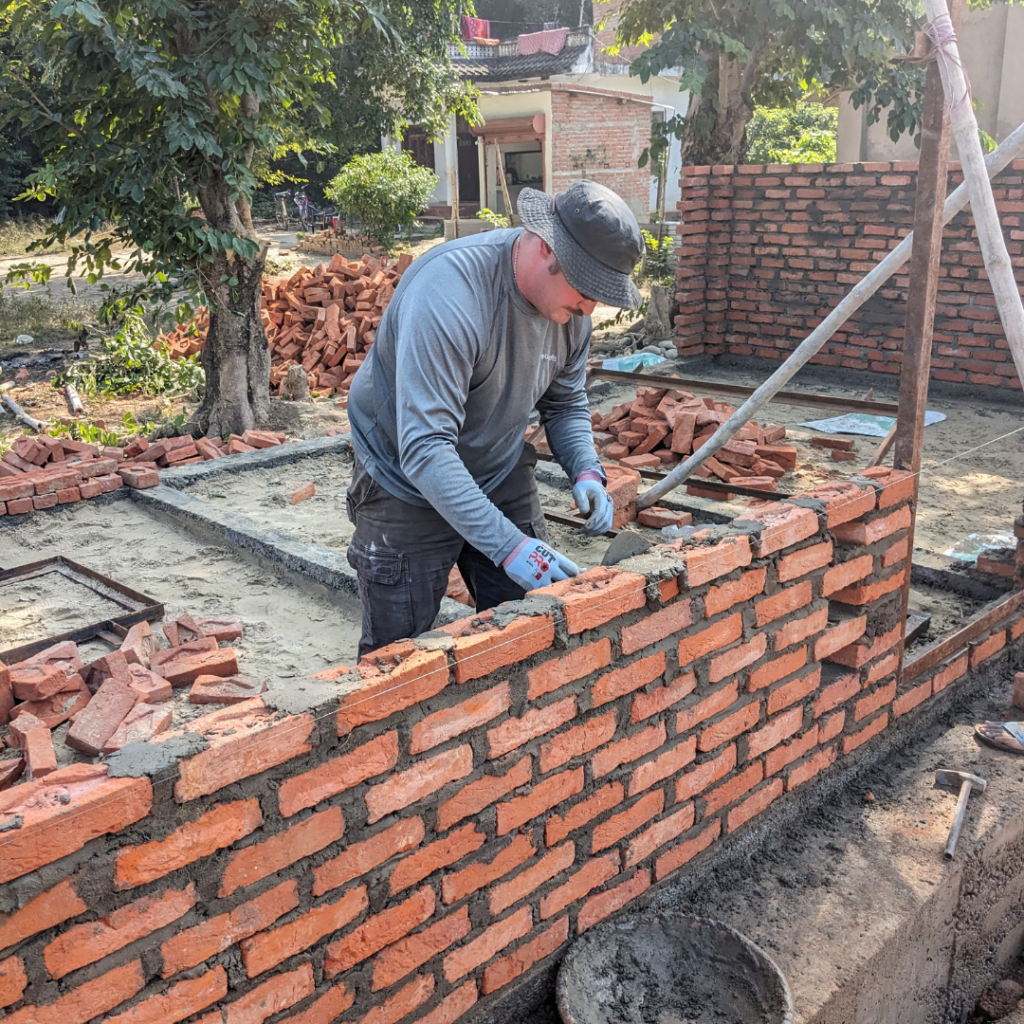
Becky and I woke up early (before 6am) and used the time again to get organized for the day. We would be departing as usual from the hotel, but then returning immediately after lunch at Unako House to depart for our cultural weekend at Bardiya National Park and the four to five hour drive that would require.
When we arrived at the work site, we could see that eight rows of bricks were complete on the north side as well as pillars of bricks 17 high on each of three corners. The rocks we’d moved from the east side had been replaced with two piles of sand that looked to be about four or five tons each. One of the women was mixing mortar while two others were sifting sand for mortar from the West pile. The kids lined up and cheered our arrival.
Our first work was to remove the remaining foundation forms and then mix concrete to complete the footer or step platform on which bricks would be laid. What remained to be done was about one-third of the foundation top. As this required lesser amounts of concrete, we mixed small piles of concrete in three decreasing size stages.
We next set to work filling the interior floor sections of the house with sand. We were told to do this until we were level with the foundation. Some of the sand could be thrown by the shovel-full directly from the piles, but much of it had to be transferred fire brigade style in tubs as we had been moving concrete and rocks.
As some of us were filling tubs and tossing shovels of sand, others used shovels and 2×4 boards to distribute and level the sand in the three interior areas. The whole team worked hard on this, including a couple of teenage boys and the usual set of four women. During this time, Sunil, his assistant, Sunita’s father, and another woman laid bricks.
We were amazed at how little the Nepali women sweated. They all wore nice, colorful clothes and worked bare-handed, with only sandals on their feet. We had boots and gloves and sweated rivers of perspiration.
We took breaks occasionally and during this time the kids jumped rope, played games with Joe and took photos with us.
Moving the sand took the better part of two hours. The delivered amount was as close to exact as one could imagine as we scraped the ground for all we could get, leaving all three rectangular areas filled to Sunil’s satisfaction. It was our impression that once complete the sand would be thoroughly soaked with water to aid in compaction. We anticipated that we would be pouring the floors next week and we’re curious about how they would be reinforced, hopefully with some sort of wire mesh as we’d used in Costa Rica on the Mar à Mar campground bathroom floors with Carlos.
Once the sand was leveled, we began moving bricks into place with two separate fire lines. We set them about 12 deep on the exterior of the foundation to be used for the walls–or really until all of the bricks were moved from the pile and evenly distributed.
By then, our work was done for the morning. In three-and-a-half days, we had mixed 28 bags of cement (50 kg each) at about a four- or five-to-one ratio with aggregate and then added water and transported a LOT of concrete. We’d moved and distributed about 10 tons of large white river rock, an equivalent amount of brick, and probably 10 tons of sand as well.
We said “goodbye” to the kids and our fellow workers and told them that we would see them on Monday or Tuesday. Sunil and a few of the locals stayed on the site to lay more bricks and we went to lunch a little early.
We made relatively quick work of lunch and returned to the hotel classic to shower and generally freshen up before our drive began. Joe stayed behind at Unako House and went back to work laying brick in the afternoon as he’d decided to pass on our national park visit. He told us that he intended to do lots of walking in the area on Saturday and Sunday.
Most of us left laundry with Dharma at the hotel front desk and also left a bag of work clothes and other things we wouldn’t need at Bardiya.
Two jeeps (actually Mahindra Scorpio seven-seaters) were parked in front of the hotel. We loaded the vehicles and left just after 1:30 pm. Hemraj joined Adam, Becky, and me in one vehicle, sitting in the back row. In the other car, Kyle and Karen were accompanied by Dinesh and a young (relatively newlywed) couple. The husband, Monaz works for CPN as an IT specialist and his wife is a Nepali-trained and certified nurse.
The trip took almost exactly four hours–about 30 minutes more than predicted by Google Maps, but an hour less than Dinesh’s estimate. After some early kilometers in the hills, most of the route took us across the plains, parallel and within 10-20 kilometers to the Indian border. The countryside was mostly farmland and smaller villages, though we did skirt some national park and forest lands.
While going through national forest/parks/preserves, the police used a novel way to enforce the speed limit. In two distinct sections that were 30-40 kilometers long, we were stopped temporarily at a highway check and given a time card. Our drivers would present the stamped time card at the exit to the speed enforcement zone and then pay a fine if the entry to exit timespan was too short or too long. We were told this was primarily to stop wildlife roadkill incidents on the straight road bordered by dense forests. The relatively slow speed limit (only 40 kph or about 25 mph) seemed consistent with that idea.
We arrived at the park entrance near sunset and drove to an area that had many park “resorts.” These resorts, like ours (The Bardiya Wildlife Resort) appeared to be 10-20 room (or hut) locations with the most meager of facilities.
We were greeted at the entrance by the properties and his wife, blessed with a red tika of pigment and handed a small flower. Our room had two dim, bare light bulbs, one electrical outlet (multi-plug compatible, though) and a large bed with mosquito net. The room had a switch and speed dial for a ceiling fan, but only bare wires on the ceiling. The interior was painted plaster, but the exterior seemed to be mud/plaster and board. We had a desk, but no chair, a clothes/towel rack and two one-liter bottles of water. We were told that there was no hot water due to a leak in the system. The bathroom was en suite, but had the typical open shower.
After settling in and plugging our electronics into the splitter from the outlet, we relaxed for a few minutes and then went outside to the small covered area in a garden courtyard with an open pit fire. The thatched cover was just low enough so that anyone over about 5′ 2” would smack their head on the horizontal beams or rafter edge upon entry or exit if they were not careful. We each suffered an impact at least once.
We ordered beer and other drinks and the owner brought out a large bowl of freshly popped corn. We chatted about world issues and other topics and then went to dinner at 7:30.
The dinner was quite good, consisting of rice, mustard greens, lentils, potatoes, “pickle,” and chicken. Conversation continued and we discussed the next morning’s plan. We were all in our rooms by 9pm.
The night was generally noisy with a party at the restaurant bar down the street, dogs barking, doors slamming, and people talking loudly. I didn’t sleep particularly well even though I’d put in my earplugs, as had Becky.
Saturday 4 November, 2023
At about 5:30am, I woke up and checked the time on my cell phone. I noticed a message from a Facebook friend that just said “earthquake?” I immediately checked new sources and saw that, just after midnight local time, an earthquake initially reported as 6.4 on the Richter Scale had struck in West central Nepal in the Jajarkot District. Early reports were that over 60 people had been killed.

I checked Google Maps and discovered that Jajarkot was only 100 km straight line distance from our location, to our east and north. It was almost exactly halfway between our worksite and Bardiya NP, but to the north somewhat. Given the roads in Nepal, a drive from Bardiya to Jajarkot was predicted to take 6:28.
Becky was awake and said that she’d felt and heard the earthquake awakened by banging shutters and people screaming outside. She had not put together at the time, though, that that was necessarily an earthquake as it was not severe in our location, didn’t last long, and she was not very alert at the time.
Now messages started streaming in from the States as it was late afternoon there and reports of the quake were hitting the major news outlets. The death toll had now risen into the low hundreds. I sent a note to DWC that we were all safe and then inquired via WhatsApp of Dharma and the Hotel Classic, to include Joe. Dharma responded almost immediately that all was okay in Lamahi and I passed that info to Joy and the Kamloops team as well.
At 6:30 breakfast, the conversation was all about the quake. Most had felt or heard it. Adam said it sounded like a stampede of wild animals. The shaking and his size had caused his bed to collapse. I sent my map showing the quake and our locations out to ll via WhatsApp, Facebook, and other social media and messaging services.
Breakfast was eggs, toast, coffee, masala milk chai, and fruit with some juice boxes. We all ate quickly, responded to friends back home and prepped for our walking safari in the park.
We all left just after 7:30 and arrived at Park gate to meet our guide, Mahindra (like the car company). He may have been the same guide I’d had four years earlier.
During the early stages of the walk through the tall grades, he told us how to behave if confronted by any of the large animals in the park: hide behind a big, sturdy tree if you see a rhino; throw your cap to the side if you see a wild elephant (they will go to the smell of your cap); and NEVER run away from a tiger. Mahindra had a four foot long bamboo pile to defend us (or just himself), as did his assistant guide.
The first obstacle we faced was a branch of the river delta area. We had to take off our shoes and socks, roll up our pants legs to the knee and wade across. I’d forgotten about this part and apologized to Becky and the team for not mentioning this–no one else (Dinesh, Hemraj, or our guide) had mentioned this prior to reaching this point.
Walking barefoot across a flowing, stony, slippery, mossy Nepali river channel at dawn was not fun. But, we took it slowly, no one fell, and we crossed the 50-75 meter channel without incident.
After putting on our shoes and socks again, we began walking. Mahindra didn’t have a lot to say, but he did respond to a few questions about the park later. We knew that Bardiya was the first Nepali National Park and know now that it counts its tigers every four years using game cameras. It claims to have about 125 adult tigers, up from 85 only four years ago. Mahindra implied that, because of a tiger’s isolated lifestyle and territorial nature, this was near the limit of what the park could support.
Early in our hike, we saw a domesticated elephant coming towards us on the trail. It had a large amount of branches and leaves on its back (presumably animal feed) and two humans. We gave it plenty of space as we passed.
We walked for over 10 km in the next four hours and saw almost nothing–a few deer in the distance, a couple of monkeys in the trees, some butterflies and insects, and a LOT of elephant poop on the trails. Mahindra told us that it was rhino poop, but I’d seen a lot of elephant poo in Africa and all of this seemed to be on main trails, so I think it was from the domesticated and wild elephants. Later, he told me that there were only 25-35 rhinos in the whole park, so this made some sense.
We stopped for extended periods of time at three locations. Two were river crossings where we sat quietly hoping to see animals pass and the last was atop a spitting tower about 15-20 meters high that overlooked a bend in a stream and some grassland and forest. At the latter, we stayed for almost 90 minutes without any explanation, guidance, or comment from Mahindra. Again, nothing but insects and a few birds–but very few birds.
Kyle checked Google and found a report that 90% of Nepal’s bird population had been lost in the more recent 20-30 years due to pollution, habitat encroachment/destruction, and pesticides. I’d never walked so far through dense jungle and grassland and seen so little wildlife. It was all very calm, beautiful, and peaceful, but eerily lacking in animals.
The morning passed almost exactly as my walking safari four years earlier–very disappointing. We waded back across the river, but this time only Karen, Hemraj, and the two guides took off their shoes and socks. The other four of us stride confidently across the slippery rocks in our shoes or boots and did it quickly.
However, upon reaching the other side, we realized that each of us leeches on our shoes, socks, or lower legs. The small devils snuck through the weave of our socks to attach themselves and suck our blood and we’re hard to remove. Blood dripped down Becky’s leg after one was pulled off. We quickly.pulled off our wet shoes and socks and found more. Each of us had at least three. Barefoot wader Karen had none.
A Bardiya three-row open-air safari van met us at the crossing and we boarded for lunch. The leach victims kept their shoes off and let them and the socks dry in the sunlight.
A few minutes later, we arrived at a sandy elevated river shoreline–the same place as four years earlier–and enjoyed lunch in the shade of a large tree while hoping for some animal crossings. Lunch was fried rice with cabbage and soy sauce included, so, disappointingly Karen could only eat the accompanying hard-boiled eggs and an orange.
It was now after 1:30 pm and we began the afternoon safari vehicle tour. Again, we saw some deer, some monkeys, and nothing else except forest and grasslands. We stopped at one very high river delta overlook and scanned the half-mile or so of the river visible beneath us, but saw nothing except for a few waterbirds. The rest of the day was a more or less silent, uninformative forest drive with nothing new to see for hours.
We returned to the park entrance at 5:30 as did the other park vehicles. None of the others seemed very enthused about their day. We certainly weren’t, except for the food exercise of a 10+ km walk.
After dismounting the vehicles, we walked to some of the big animal enclosures. Three domesticated elephants were confined (by leg chain) for the evening, all eating hay. There was one Asian rhino in an enclosure that seemed very young and friendly, reaching its head over the wall to smell our hands and respond approvingly to us petting its muzzle. Mahindra explained that it was a young transplant from Chitwan National Park in Nepal (the center of their largest rhino population) and would soon be released at Bardiya to join the locals and help add to the population.
Another cage held a large Bengal tiger that paced its two-level cage. It was a beautiful animal, but difficult to see in its dark, old-fashioned (even if large) cage. I asked Mahindra about it and he said that it was caged because it was a “man-eater.”. That seemed odd to me, suspecting that, given the chance, just about every tiger could be described that way. I also wondered about the choice to cage such a beautiful animal versus just putting it down, or if it could be released in some location and country where it could avoid people altogether, or be sent to a modern zoo. I didn’t ask any more questions.
We boarded the vehicles again and returned to the resort for a shower and dinner. On arrival, the owner told us that there was still no hot water, but that the other building of rooms did have it and that we could shower in those. Kyle and Adam took him up on the offer, while Karen, Becky, and I resolved to tough it out with cold water in our rooms.
By just after 6:30 pm we were all gathered around the fire again, eating popcorn and having drinks and conversation. The beer was good, Becky and Karen again had rum-and-cokes, and most of the talk was of the earthquake again. After dinner, we returned to our rooms for the night.
Sunday 5 November, 2023

Again I didn’t sleep well even with earplugs, and was awake half of the night. Just after 7am, we went outside and sat around the extinguished fire pit to enjoy some hot milk tea with Karen and Dinesh. Adam and Kyle were communicating back home with the phones in the dining area.
Our final breakfast was fried bread with a spiced potato, pea, and black beans stew along with curd containing cut fruit. We had more milk tea and then settled our total excursion bill with Dinesh.($211 US each for all meals, lodging, transpo, guides, etc) and our bar bills with the resort owner. One 650 ml bottle of Ghorka beer (the equivalent of two standard American 12 ounce cans) was 500 NRs or about $3.75 US. A rum-and-coke was $3 US.
We loaded the bags and started back to Lamahi just after 8:30 am. Google maps predicted a 3.5 hour drive. We stopped once for a bathroom break and snacks. The owner of the shop also brought us some milk tea and we relaxed along the highway for about 20 minutes. I used the time to write and also read which wasn’t too difficult because the roads were much better than they had been in 2019.
We arrived back at the Hotel Classic (Becky said she never thought she’d be happy to come back, but the Bardiya “resort” made her miss the place) at 1 pm and were greeted by Dharma at the door. We all went back to the same rooms after gathering our luggage from the vehicles and the bags that we’d stored. Dharma also gave us our laundry that we’d left on Friday.
We spoke with Dinesh about the plans for the next day. The bicycle giveaway had been pushed back to noon, followed by the community picnic, so we wouldn’t be leaving the hotel until 10:30 am the next morning. We would have breakfast at the usual time and then take tuk-tuks to see the work site before continuing to the school for the day’s events. That would leave us only three more days of real work at the house. Finally, we talked with KAren who wanted to go for a longer walk in town later in the afternoon just for the exercise and agreed to meet at 4:30 pm in the lobby for that.
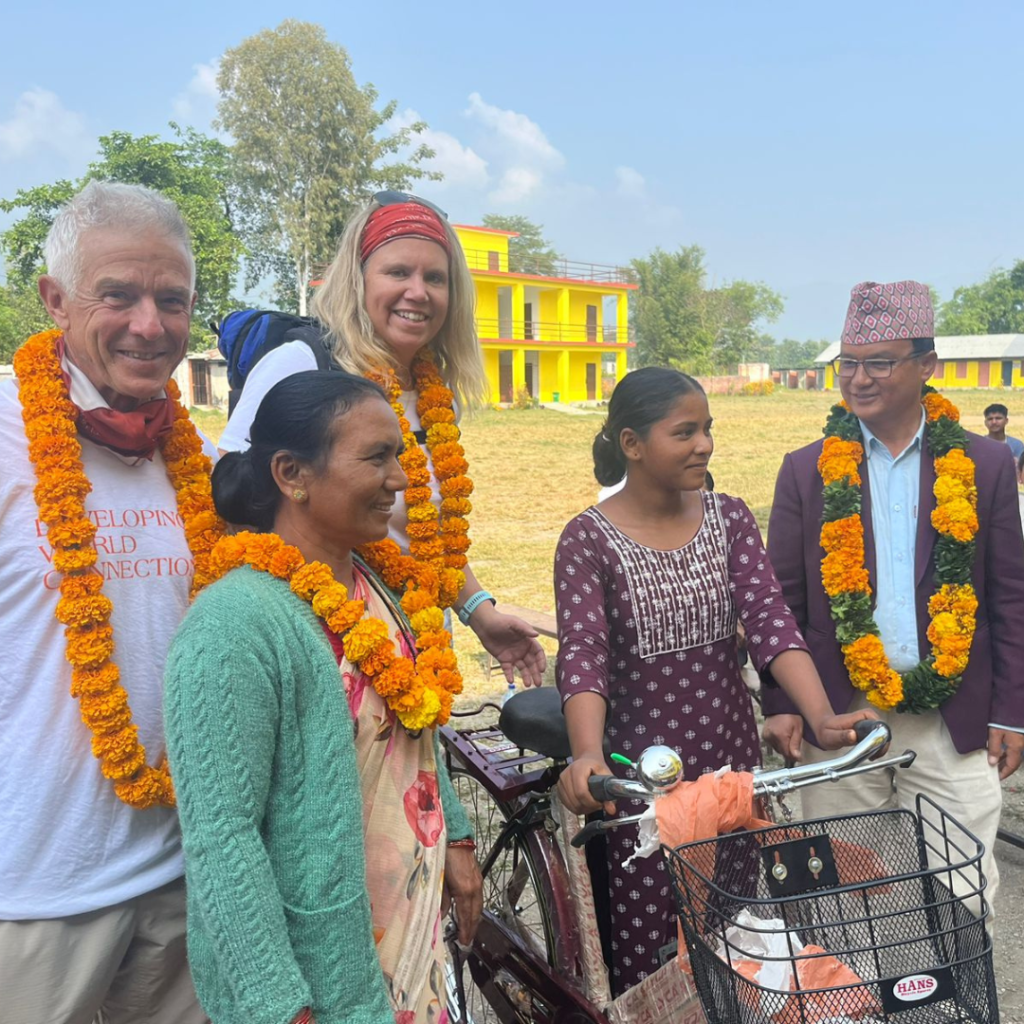
Back in the room, I took a hot shower and did some sink laundry with underwear. Our boots were still a little damp from our trek and river wading, so we set those outside. In general, we prepped the room for the four days, in good spirits knowing that we seemed to have planned things pretty well and felt good.
At 4:30 pm, Joe, Adam, and Karent met me in the lobby to go for a walk in the town of Lamahi and get a little exercise. Adam and Karen also wanted to visit an ATM to get some more cash. We started with the same route as usual, walking by the cricket pitch and police barracks before turning left into town, but continued farther into town and took a right down a minor street and into a more rural and residential area. I was impressed by what seemed to be many more new, three- and four-level homes built in the last few years, most with bright paint, polished external stairway railings, concrete fencing around the property, and relatively new cars and scooters in the driveway. Most seemed to have air conditioning units attached to one or more windows as well. Being Nepal, though, some of these home sat amongst rice fields or had goats tied nearby (or both) and were only steps away from another family’s quarters that were really just a barn shared with animals, mud hut, or simple single-level block or brick home like we were building for Sunita in Gadhwa.
We wove our way back into the main part of town and Karen stopped into the local minimart to buy some shampoo. On the return to the hotel we went farther west than usual and walked through another neighborhood of mostly new homes, though outside of one the owner was burning trash next to the goat pen.
Just after 5:30 pm and about 2.5 miles of brisk walking, we began happy hour in front of the Hotel Classic with the usual round of beer, cider, and popcorn provided by Dharma. At 6:30, we went inside for dinner and away from the mosquitoes outside. Several cars drove by the hotel with drivers and/or passengers stepping in to inquire about rooms. It seemed that, for the first time I could remember, the Hotel Classic would be full for the evening.

Dinner was the usual rice and dal, with cauliflower, okra, mustard greens, and chicken chunks in a mildly spicy red sauce. The okra (called “lady fingers” in Nepal) was particularly tasty and Dharma was generous with doling out seconds.
Kyle went upstairs after dinner and the remaining five of us played cards until about 9 pm before retiring for the evening. I won at “Oh Hell” and Joy triumphed again at “Golf.”

Monday 6 November, 2023
Becky and I did not sleep well, again, on the hard mattress, but were up just after 6:30 am. We went downstairs for breakfast and conversation, greeted by Dharma and cups of Nescafe milk coffee, hot and frothy.
Today, the schedule was very relaxed. We would not be leaving the hotel until about 10L30 am, going first to the work site to see what Joe and the others had accomplished in our absence. After that, we would go to a local school where we would participate in the distribution of 25 bicycles to local girls to be used for school transportation from home. That would be followed by a community-sponsored picnic. There were no other plans to return to the worksite later in the day, so we realized we really only had three more work days ahead of us before flying back to Kathmandu Friday morning.
We jumped into our tuk-tuks at 10:30 and traveled more than 30 minutes on the main road to the east of Lamahi, following Dinesh and Hemraj on a motorbike. We turned off of the road towards a school only to find that we were at the wrong school. We then reversed course and went west for about five kilometers to the town of Rapti. There, we found a bright yellow school with a large gate by the name of Shree Shankar Secondary School, arriving at about 11:30 am.
We walked past a flock of ducks at the gate and then entered a courtyard area between school buildings. On the right was a shiny line of 17 new bicycles with a mechanic tightening the head set, installing pedals and a bell, and generally checking over each bike. In the courtyard were about 50 parents, staff, and students with as many chairs.
We were introduced to several of the attendees including the local mayor and several members of his city council representing different districts in Rapti. Deepah, the Creating Possibilities Nepal Coordinator (who seemed to be in charge of this operation) was explaining to a group of girls the contract they would be required to sign to get a bicycle. Clearly, the kids receiving bikes had already been determined.
I was told that the kids getting bikes had to live at least a 30 minute walk from the school. They had to agree to stay in school–if not they would have to return the bike. They also agreed not to sell or rent out the bike and to keep a bike log of their uses. They could use their bikes for going to and from school and also for work and errands around their home and to help transport family members. The contract they signed was very official looking and after each kid signed their contract and filled in some personal details on a roster, Deepah used a very official looking blue ink, round rubber stamp to certify the contract.

The contract signing process took quite some time. Most in our group were comfortably seated in the headmaster’s office. I took photos outside. The headmaster and a young man who said that he was the boxing/martial arts coach took us to see some classrooms and walk around the school area. We entered a model elementary school classroom that was quite unique with an oval-shaped low desk set-up where all of the students would sit around this very large common table that had an open center.
The ceremony started at noon and included speeches and explanations from Hemraj, Deepah, and the mayor. Happily, we were almost all in the shade. Above the assembled bikes to our right was a very nice sign proclaiming the event, with symbols of Nepal, CPN, and DWC made by Dinesh
Our group was greeted with garlands of marigolds. The speeches continued, all in Nepali, One of the city council members sat next to me and did some translation. I was asked to speak and used Hemraj as my translator. I expressed our appreciation for the warm welcome and our happiness as a team to be there representing DWC. I also spoke to the importance of education and the love of cycling that Becky and I (and the whole team) had.
Another truckload of bikes arrived with 13 more bikes, They were quickly unloaded and assembled and the kids were lined up with their bikes for photos. The mayor and I were each given a bike for a test ride and I followed him in a loop around the large athletic field that adjoined the courtyard area.
When we returned, the kids were all behind their bikes and given the chance to ride them in a similar loop. The bikes appeared to be made in India and were the common step-through type that we’d seen everywhere. The bikes were single speed, with fenders and caliper breaks that contacted the inside of the rim, not the side wheel rim as in most bikes. The brake connection was also unique in that they didn’t use cables, but rather long push-pull rods were levered from the handlebars by long, thin steel rods. There was a spring-loaded cargo/passenger rack behind the seat and also a key locking mechanism near the rear brakes. Overall, my guess is that each bike weighed 15 kg, They were VERY heavy, but sturdy, made to handle the Nepali paved and dirt road with beefy tires.
The protective wrapping around main frame tubing remained on the bikes. We saw little effort to remove it, though some had, just dropping the paper and plastic wrap on the field.
After even more photos, we left the school at around 1:30pm and drove several kilometers to a large park dominated by a lake at the base of the hills for a picnic planned by Dinesh and CPN.
The park area was very nice with pavilions for picnickers, paddle and motor boats on the lake, and very nice views, As usual, though, there were several stray dogs in the area that took advantage of the picnickers to savage food.
The whole CPN team from Unako House in Dang province was there, bussed to the site by Santos who had been our driver during the 2019 trip. It was great to see him again and he was pleasantly surprised when I greeted him by name.
The ladies in the group had prepared a great meal, most of which was prepared over an open flame barbecue pit. It included rice (of course), grilled chicken and pork on skewers, black chickpeas, cauliflower, and a potatoes, greens, and green chile dish with peas that was very spicy. We all sat around and enjoyed the food. The CPN families brought their kids, and they were all having a wonderful time. One little girl was almost exactly the same age as our youngest grandchild.

After eating, there was Nepali dancing and then some of the group went onto the lake in boats. Karen and I used the time to walk around the lake and get a little exercise, going clockwise on a one kilometer path. We met Kyle going the other way on our first lap. We ended up doing three laps and several people went on the lake after the first group returned. The light was very nice and the peaceful and calm nature of the lake was refreshing.
After our third lap, Karen and I met the others at the gate who reported to us that another earthquake had hit while we were walking and that it had registered around 5.3 on the Richter scale. Early reports had it hitting near KAthmandu, but more refined reports showed that it was west of us closer to where we’d been in Bardiya. Fortunately, this time, there were no reports of injuries or death. Becky had felt it, as had others that were sitting near the shoreline on a concrete platform.
We returned to the hotel by tik-tuk at about 4 pm and told Dharma that we wouldn’t need dinner until at least 7 pm and that, based upon how much we ate at the picnic, it should be pretty light. We sat outside for happy hour and enjoyed our usual drinks before going to our rooms to freshen up for dinner.
At 7 pm dinner was the same as usual. None of us asked for seconds, though, and we were challenged to eat the first serving. Afterwards, all of us played cards ( a game of Oh Hell followed by Golf) before returning to our rooms at about 9:20 pm.
Tuesday 7 November, 2023
Becky and I slept as well as we had for any night so far in Nepal, getting up at 6:35 am. The air was terrible again, with visibility no more than 150 meters due to lots of fog added to the smoke. Reports from Delhi indicated that it was even worse there. I sent a note to the DWC leadership just alerting them to the situation and then talked about it with the team to make sure that all knew that they should pace themselves and not be afraid of taking a break during the work day if the bad air was affecting them.
At 8:30 am we left for the work site, arriving at 8:50. One full wall on the north side was nearly complete with 17 layers of bricks the south wall had five layers. We immediately started to work mixing mortar and preparing to lay more bricks. Karen and Becky worked at sifting more sand for mortar while Kyle shoveled. The rest of us went into the house and worked with Sunil and the team at laying brick. Most of what we did to help was filling in the gaps between bricks set by Sunil and his assistant as well as placing mortar on the bricks for a new row.
We worked quickly and the time flew by. We didn’t have many kids watching us this time, but several of the women helped with mixing mortar and concrete as well as transporting it to us while we worked.
We moved four steel door frames to the house from a storage area near the worksite at set them into the interior. We set the front/entry door into the brick and mortar first, with Sunil using a water-filled piece of clear plastic tubing as a level, much as I’d seen the same thing done by Carlos in Costa Rica on our two trips there.
The door was set and fixed in place by bamboos scaffolding pieces that Adam had loaded into a truck a little earlier in the morning after being transported to the building materials store on motorbike by Shyam. Sunil used the water and hose level and plumb bob to set everything in place.
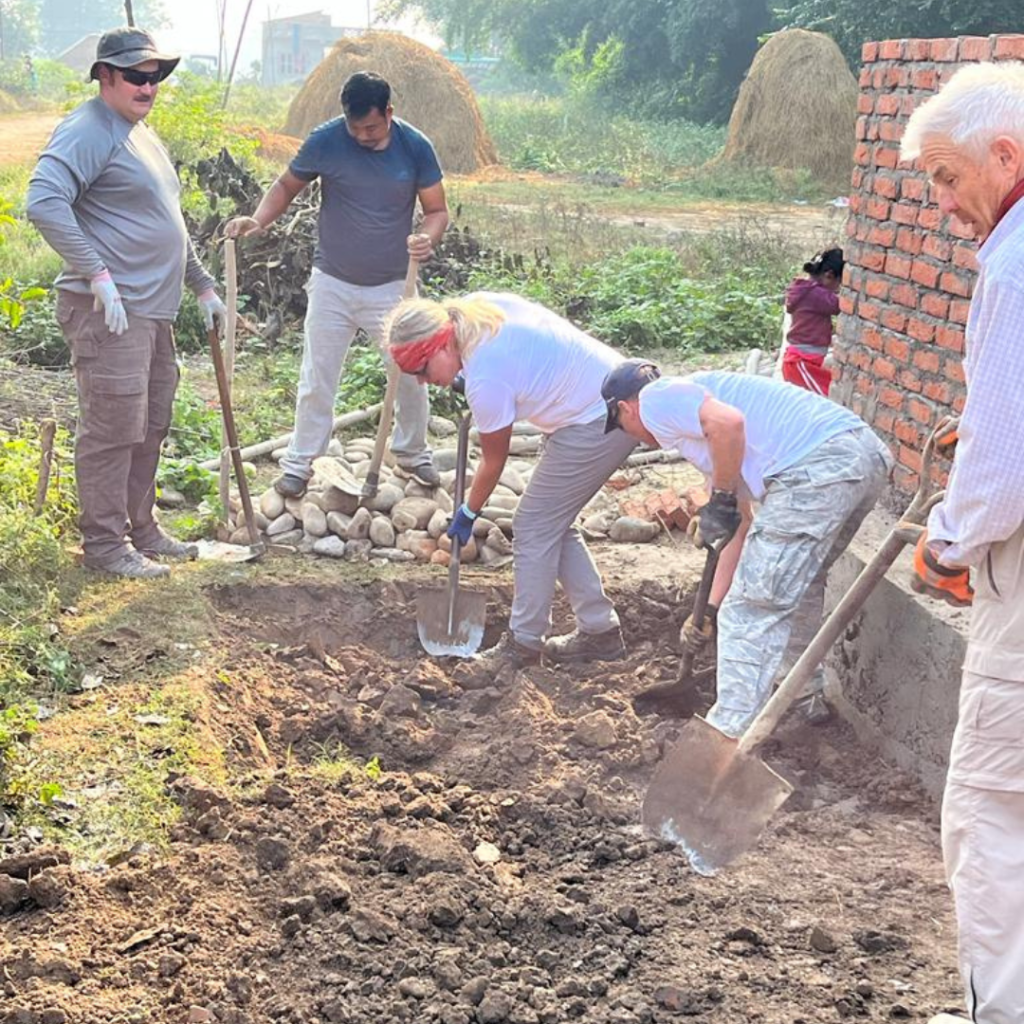
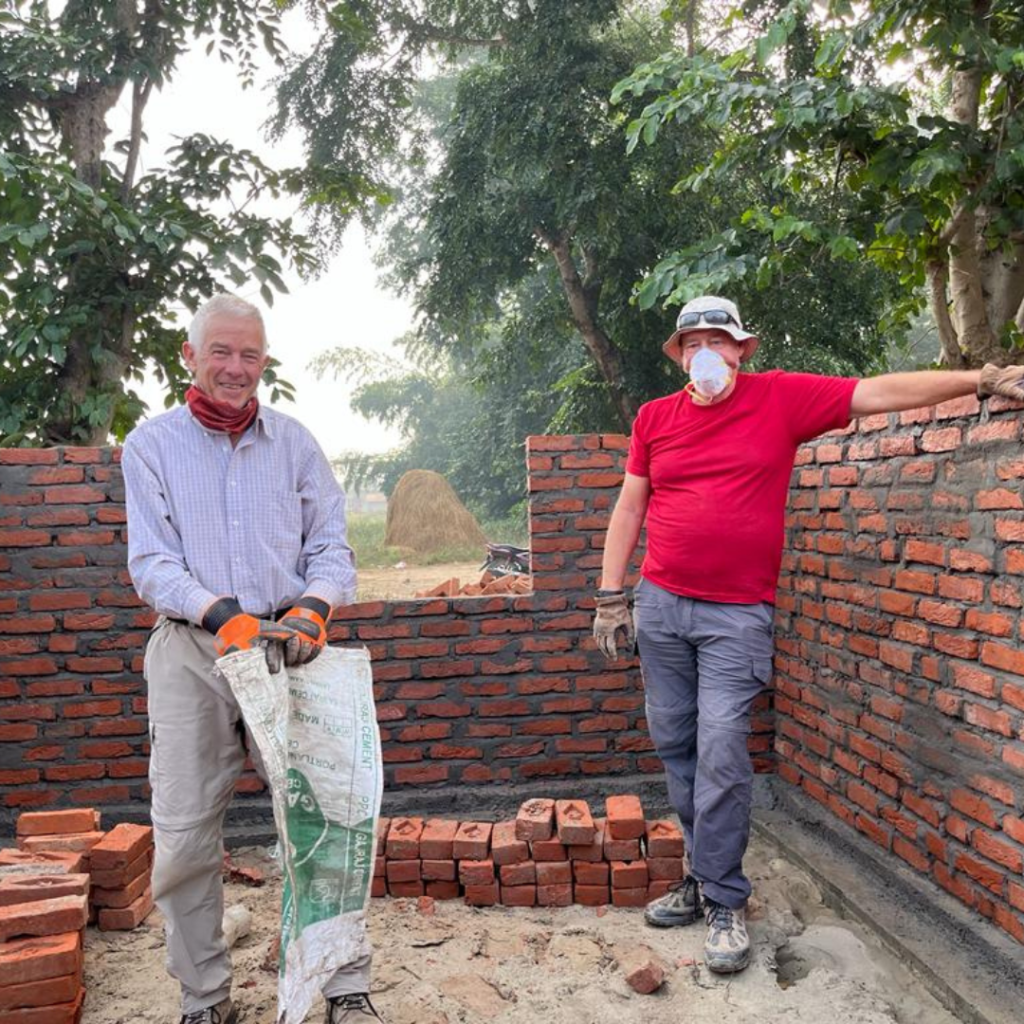
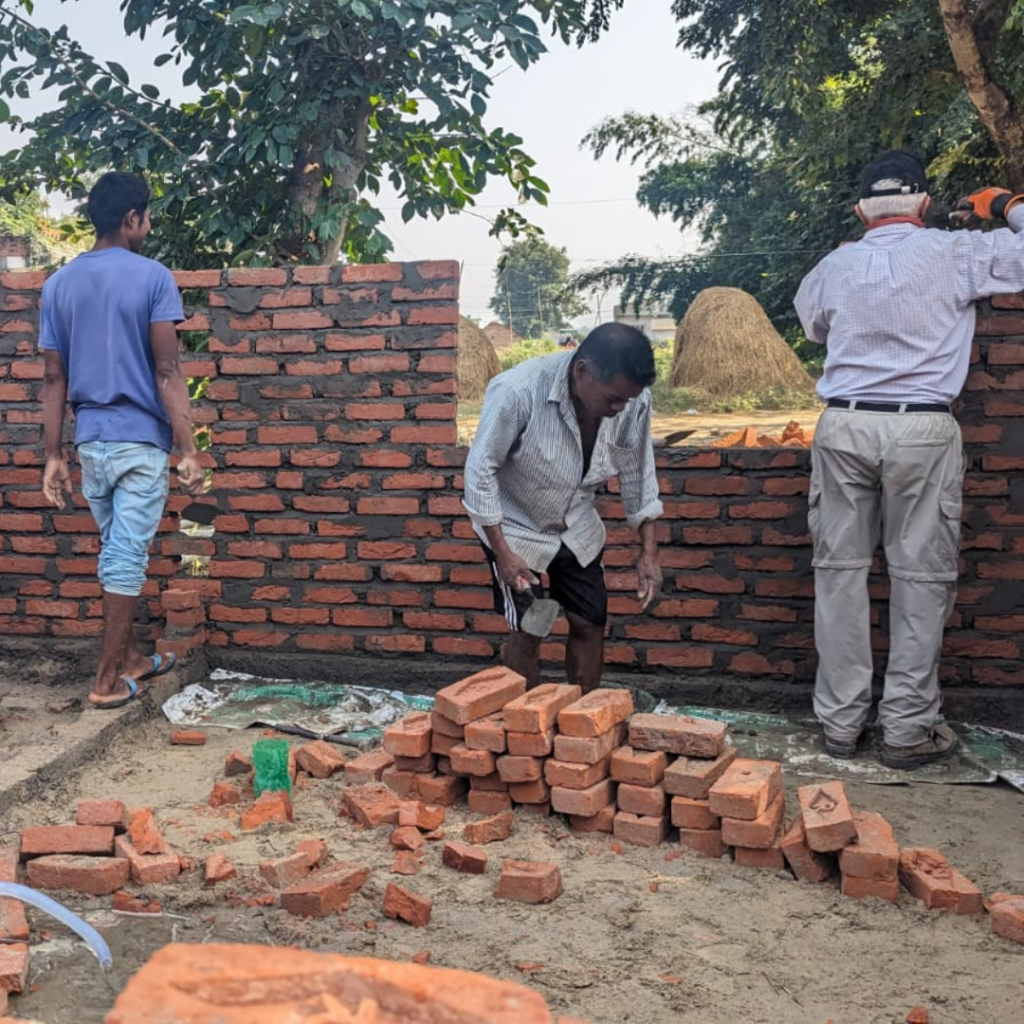
Meanwhile, we worked on more and more brick laying. The south wall was done and then we moved to the back or west wall around the front door and then the east wall. Becky, Karen, and Kyle continued to work on the sand and had to move the white river rocks for the third time to get access to more sand.
We broke for lunch shortly after noon when a pile of mortar was completed. We moved more sand and cement mix to the mixing area, but decided not to add water until we returned from lunch.
Lunch back at Unako House was our favorite: hot rice and coconut pudding, fried brea, and a spicy potato and black chickpea mix. We had plenty of ice cold water along with this and many of us had seconds. I, again, asked for recipes and mentioned to Dinesh that CPN needed to publish a Nepalese cookbook with the recipes for what we’d been served in the previous days at lunch.
In the afternoon, we returned to the site and went through two move mortar mixes laying bricks. We completed about 10 rows on the back wall and then started on one of the interior walls into which we mounted another door frame. Finally, at 4:45 pm, we called it a day. It hadn’t been our most intense day of work, but we’d all worked almost non-stop on brick laying, sand sifting, and mortar mixing, since before 9 am.
The trip back to the hotel was almost marred by an accident in which the lead tuk-tuk had to swerve at the last instant to miss a very young water buffalo calf that had darted onto the road. It was one of several close calls we’d had during the trip on Nepali roads.
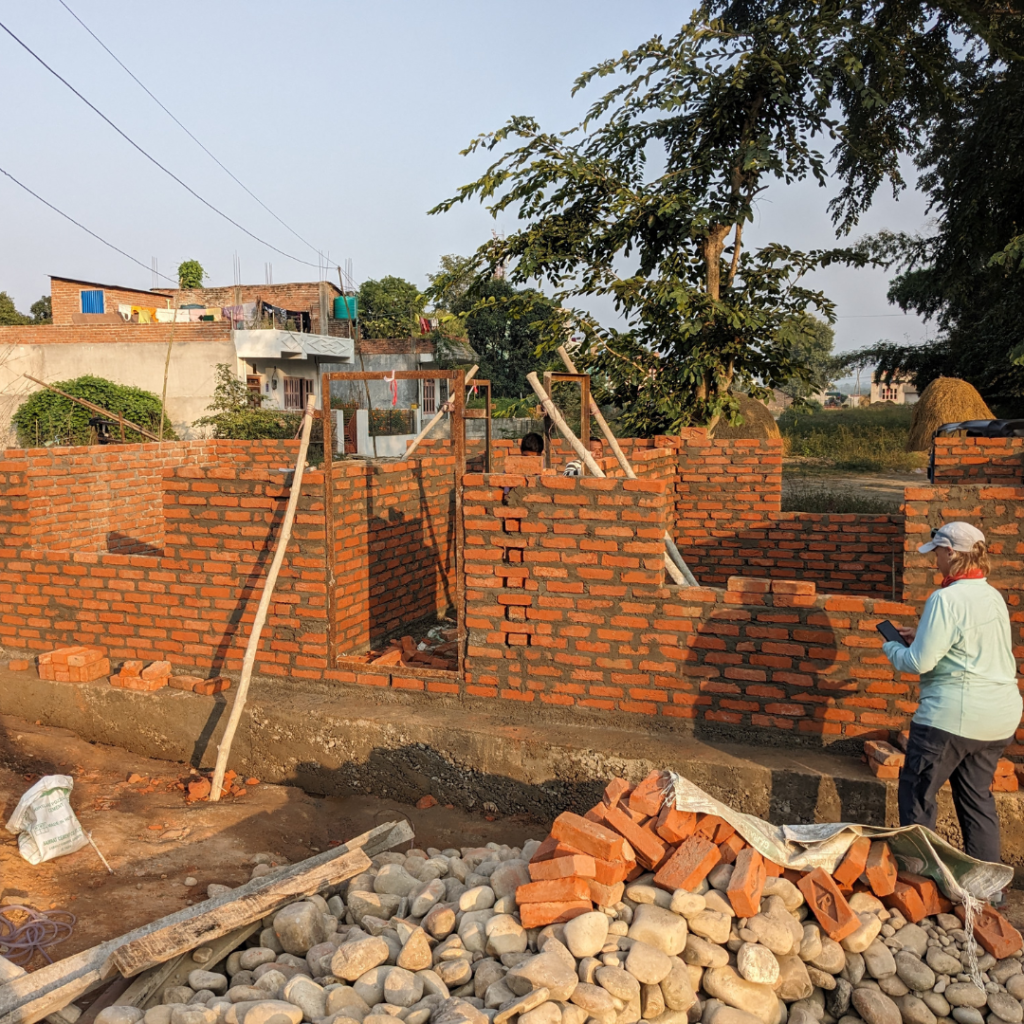
We were back to the hotel by 5 pm and we all stayed outside on the newly set concrete platform in the middle of the road median that Dharma and the Hotel Classic folks had set. By now, the air was clearer and we enjoyed the cool evening air along with more of our favorite beverages. Joe walked down the street for an ice cream from a place he’d found over the weekend.
We told Dharma that we would like dinner at 6:30 pm and he agreed. At 6 pm, we went to our rooms to clean up before dinner.
Dinner was the same plate with our every-other-day chicken chunks in spices. Tonight, we almost all asked for seconds. We were tired and hungry after a long and very productive, if not intense, day.
All but Kyle stayed in the lobby area for cards after dinner. We only played one round of Oh Hell tonight, with Karen winning. By 8;20 pm, we retired to our rooms. It had been a very good day. The team got along together great, there had been no drama to date, and we were all amazed that we only had two more work days. We discussed the project and all hoped that we would be able to complete the brick laying before we left, and maybe we’d be able to pour the floors. Nonetheless, we were very happy with our progress to date and energized for the final days.
Wednesday 8 November, 2023
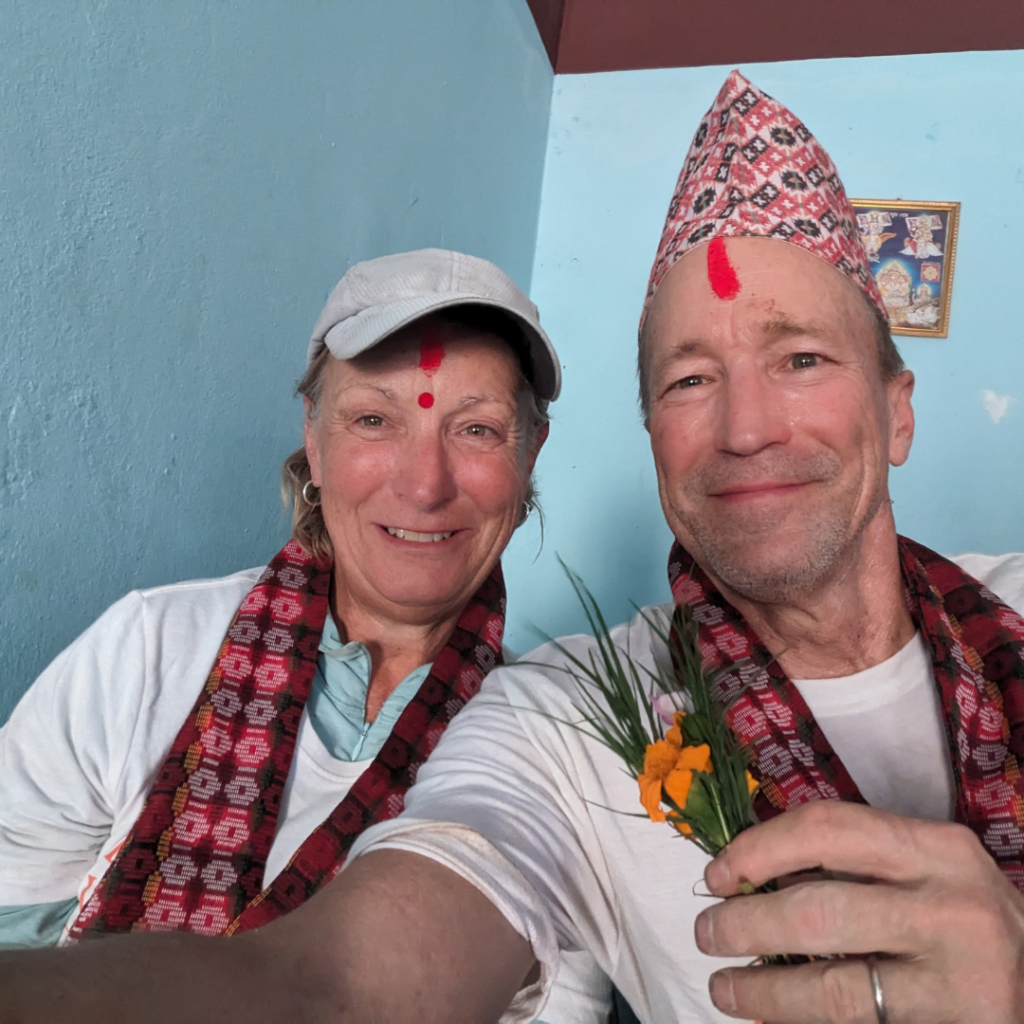
We woke up just after 6 am after a decent night’s sleep. My scratchy throat and sinus irritation seemed to have gotten worse overnight. I took some DayQuil for the day. Over breakfast we talked and others in the group complained of similar ailments. Joe took a CoVID test and was negative. Since I had no other symptoms that might suggest CoVID, I decided not to take a test. Other than the scratchy throat and drainage, I felt totally fine.
We discussed how the day might go, wondering if, once we put up scaffolding to do higher brick work, the pace might slow down. The group is very intent on getting as much of the brick and floor work–anything involving concrete and brick and mortar work done before we leave Friday morning.
The air quality seemed about the same this morning. The fog settled in again and we all hoped that things would improve in terms of air quality later in the day.
When we arrived at the work site, there was a new pile of sand for mortar. It was going to be another brick laying day and the sifting and mixing began immediately. Adam used some poles and helped rig a more efficient system for the “Sift Sisters,” Becky and Karen. There was already a dry pile to be mixed with water waiting for us and Sunil and his helper were on hand.
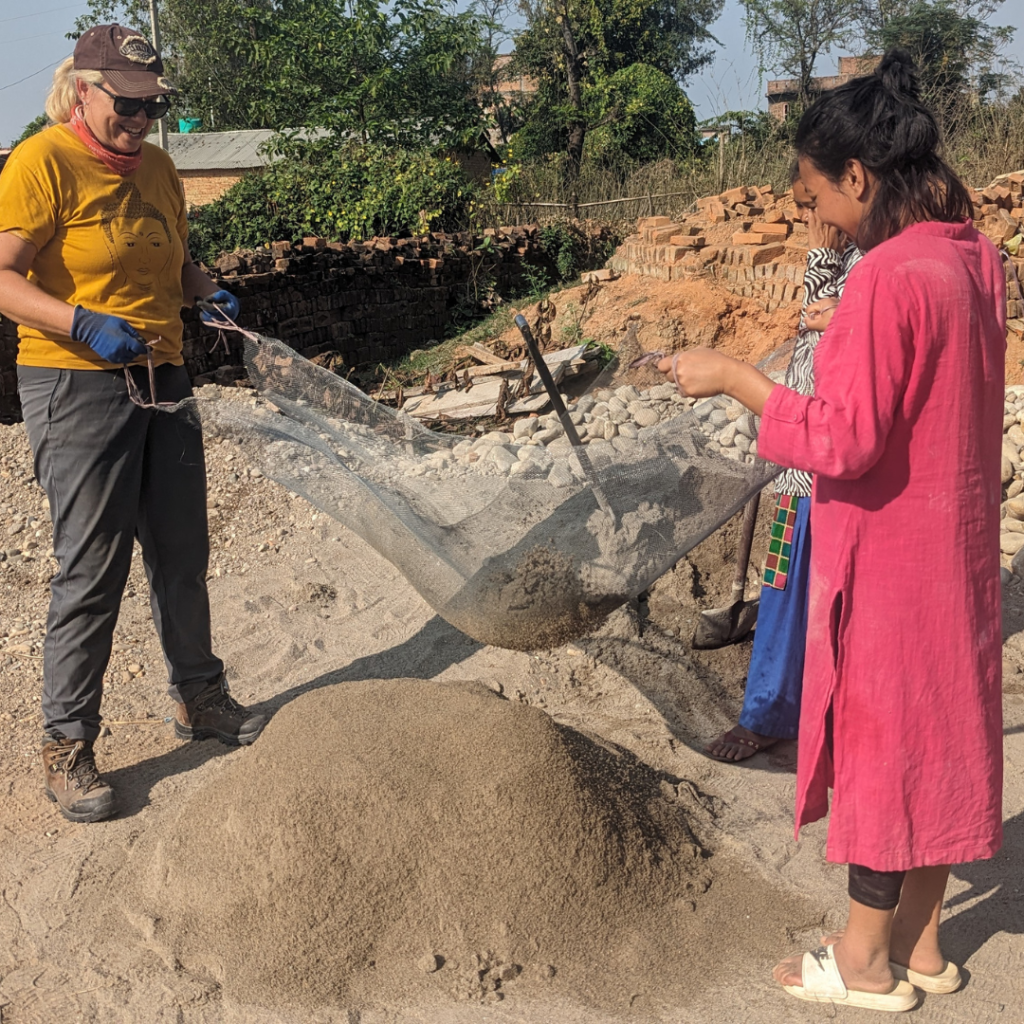
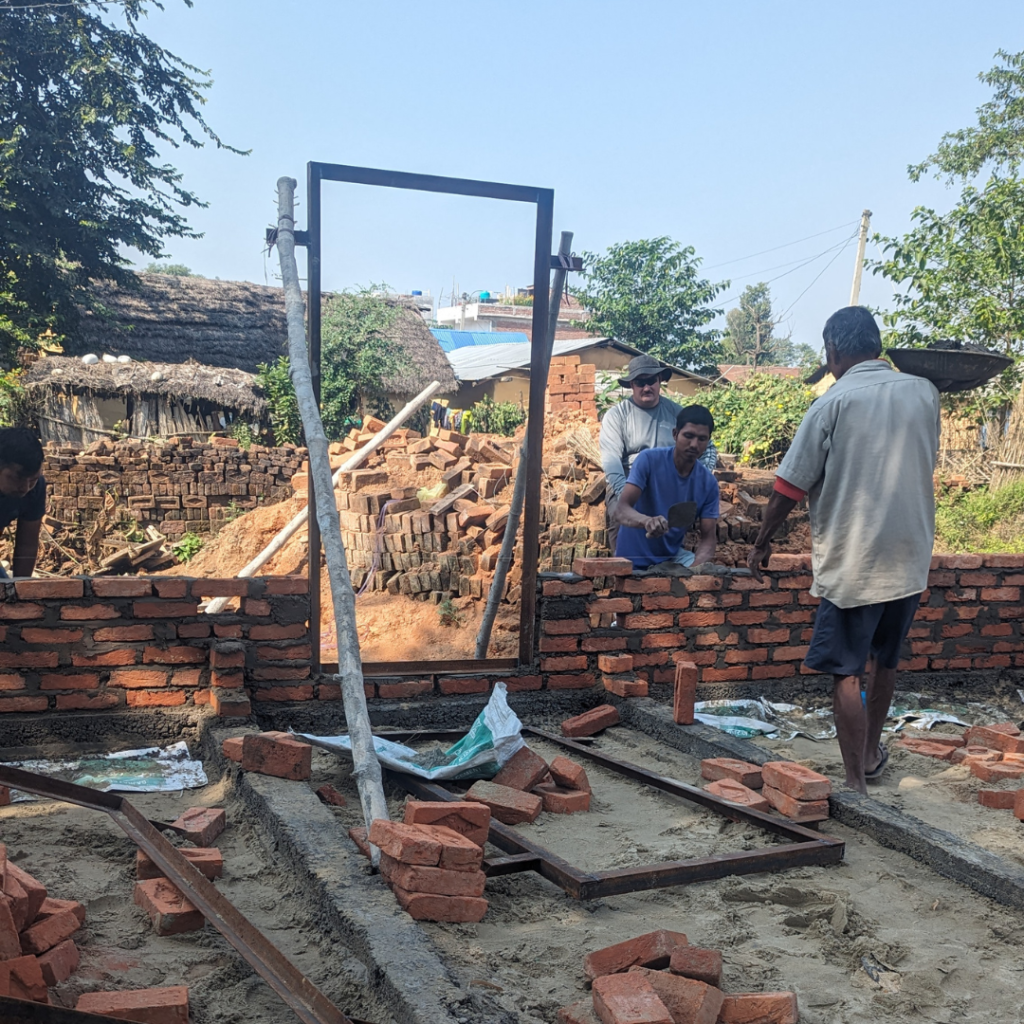
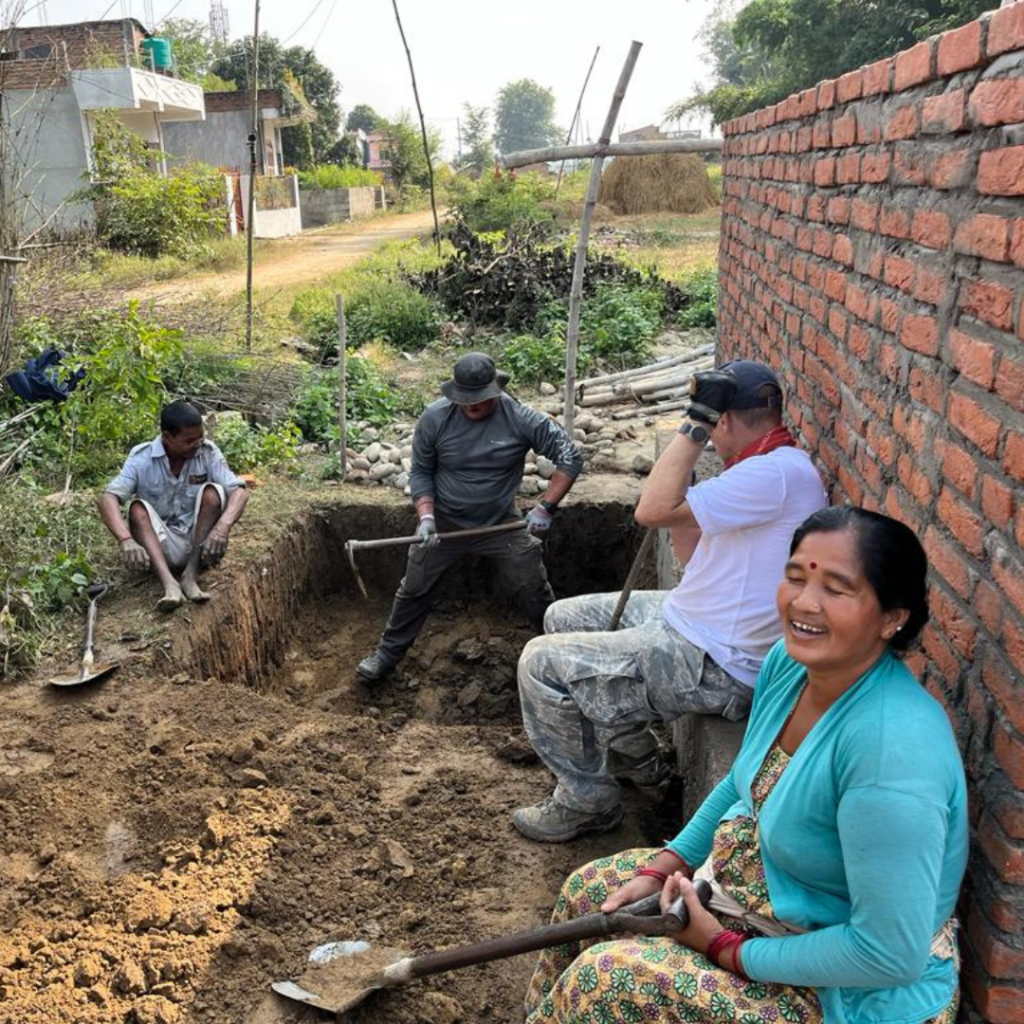
Shyam told me that they were installing a hand pump water well at the northwest corner of the house and the ground was being prepped for this by three guys digging a hole about a foot deep and then filling it with water. From there, they brought in what looked by two inch galvanized pipe and pounding it into the ground. Water was flowing the whole time. They used a combination of log levers and a post hole drive made from what looked to be some kind of vehicle drive shaft that was very heavy and fit over the pipe. As they pound in each long eight to ten foot section of pipe, they added more water and attached another pipe to the first one, repeating this process as each segment was pounded into the soft ground.
They hit water quite quickly (after just a few meters) and water was splashing out of the top of the pipe with every drive into the ground. Adam thought that they used at least four pipes and went down about 35 feet. When this was done, they attached a hand pump to the top of the pipe and tried to use it. It didn’t work. Either the pipe was clogged or they’d actually gone too deep. They worked on it for about an hour before fixing the issue and generating a steady stream of clear water from the pump.

Meanwhile, water was also being pumped into the floors of Sunita’s house to help settle the sand on what would become the concrete floors. We worked on all of the walls, sloshing through the water. Sunil mounted another interior door frame on the room to the right, just as he’d done on the left side.
We really had too many people to do this work and it was an easy day. With two bricklayers, there was only so much that the six of us could do once KAren and Becky had sifted so much sand. We filled gaps, added mortar, Joe placed some bricks, we kept the area clean, but mostly we just tried to not slow the bricklayers down.
At lunch, we had more noodle soup along with cauliflower and fried bread. They fixed more pounded rice for Karen. Joe was not feeling well due to a scratchy throat and Dinesh offered him some hot turmeric water. I asked for some, too. When it was served ina coffee cup, the hot concoction was almost undrinkable. It was very salty and tasted like very yellow, salty, noxious chicken broth. Joe couldn’t drink it, but choked it down. Adam added enough water to make Joe’s cool and then put it in a water bottle for him to drink.
We returned to the worksite for more bricklaying. Becky and Karen were clearly bored, as was Adam. We worked on the interior walls the rest of the day. Near the end of the day, Shyam told us that tomorrow we would be digging an outhouse hole. Of course, we wondered why we were being told this now since, had we known, we could’ve been digging all day instead of sitting around.
I took a break and did a walk in the community for about 20 minutes, taking photos and meeting some locals. When I returned, we finished as much of the final interior wall as we could given the available mortar and called it a day.
When we returned to the Hotel Classic, I talked to the team about some issues associated with the end of the trip like tipping our drivers, final Frida meal, maybe some gifts for the kids in the area, etc. We dropped our things in our room, hit the washrooms, and then went for a walk downtown. Adam and Karen joined me and we visited an ATM for cash. From there, we hit a small sporting goods shop and bought three soccer balls to give to Unako House for play there or to distribute to local kids as they saw fit. Each ball cost only 750 NRs or about $6 USD.
We walked back to the hotel and then sat in their new street seating area and ordered drinks. Becky and Joe arrived shortly after, having visited another local hotel that Joy Demsey of DWC asked us to evaluate, the Hotel Siddartha, about 200 meters away. They liked it quite a bit–much nicer, good restaurant, and s swimming pool. We talked over the advantages and disadvantages of the choices. We liked Dharma and the Hotel Classic in part because we felt like we were truly helping a small mom-and-pop type place, but the Hotel Classid did have its drawbacks–it was very simple and the food menu was very, very limited.
WE met for dinner at 7pm and it was much the same as every night–even though it was very tasty and healthy. Afterwards, we played cards, though Joe opted to go to his room and read. We retired to our rooms at 9:15pm, looking forward to our final work day.
Thursday 9 November, 2023
I did not have a good night of sleep as the cold that I seem to have picked up, aggravated by the bad air, has gotten worse. I coughed up crap most of the night. I took a CoVID test in the morning and it was negative. I took some cold medicine and we decided to go by the pharmacy on the way to work in the morning to get some cough drops for both Joe and me–and any others that may be suffering.
Becky and I put together our things, separating what we plan to give away to Creating Possibilities, what is dirty and won’t be touched until we’re back in Colorado, and what we have left to wear in the next three-plus days.
Breakfast was fairly quiet. We began to make arrangements to pay for laundry and other incidentals with Dharma and communicated with Dinesh about the best way to pass out the soccer balls today. Joe and I laughed about digging a toilet on our final day–something both of us have done many times on previous DWC trips. We left the hotel on time at 8:30 am.
When we arrived, Sunil and his assistant were beginning to assemble the scaffolding. The first seemed to be braiding and twisting strings of twine together to make stronger bindings for the bamboo poles. There was already a hopeful pile of mortar mix in the usual area, but it wouldn’t be used for many hours. There was plenty of sand already sifted, so Becky and Karen had nothing to do on that side.
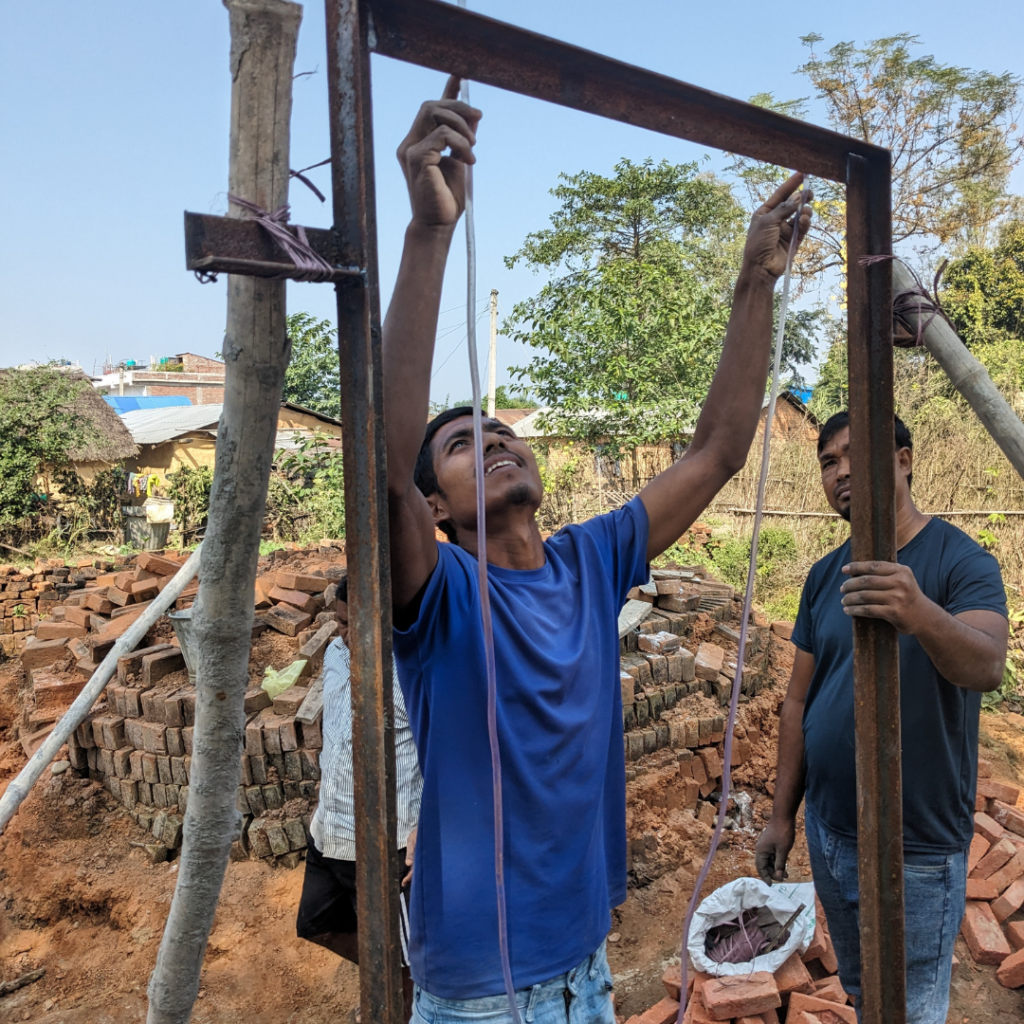
We asked Shyam about the toilet pit we would be digging and Sunil came over to measure and stake the area. It adjoined the eastern half of the north wall and was five feet by six feet. We were then told to dig the pit three-and-a-half feet deep.
We went immediately to worked marking the rectangle with shovel cuts and then taking turns with the large hoes (or adzes?). Becky, Kyle, Joe, and Karen helped Adam and me dig at first, but then as the excavated pile grew and the pit got deeper, they worked on moving and spreading the soil into low wet areas near the newly installed hand pump.
The work was very, very tough and everyone seemed to be working as hard as at any point in the trip. Adam, especially, was doing a great deal of digging and throwing and I was working into the rotation, too.
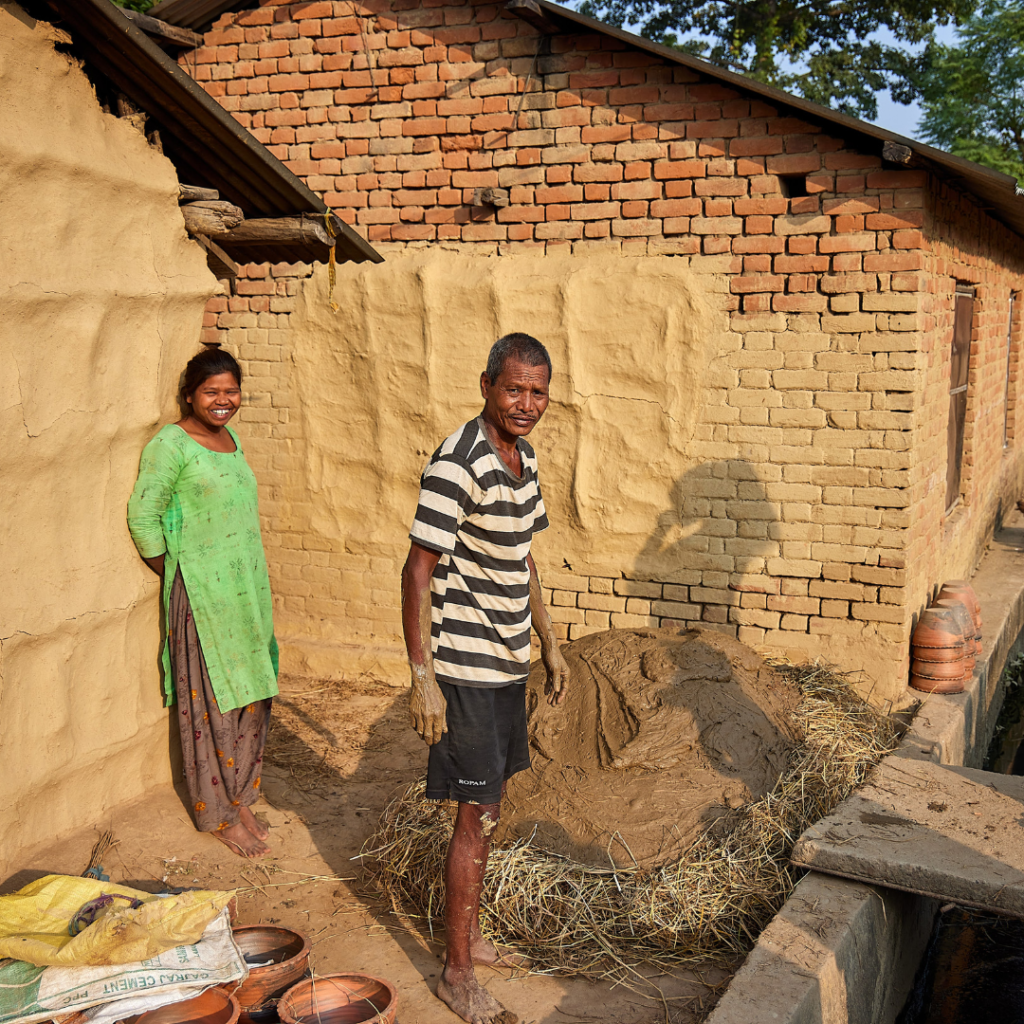

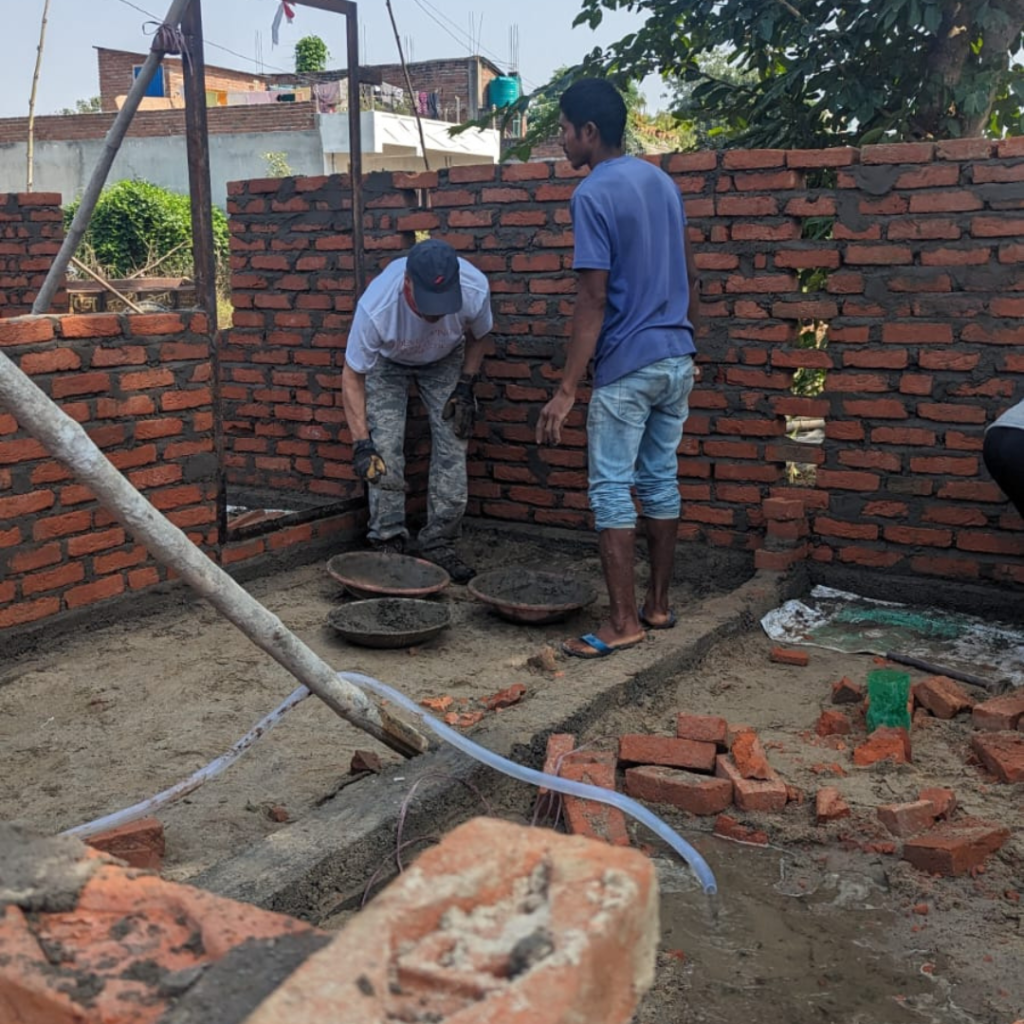
Our favorite local woman that Adam had nicknamed “Tractor Lady” for her strength and ability to work in colorful clothes and flip flops without sweating worked with us for the first hour or two.
Meanwhile, Sunil and his buddy worked on scaffolding alone. They dug holes to plant the vertical supports and then lashed horizontals to those with the other end resting atop out the brick walls. Then, they put the scaffolding walkway parallel to the walls by using four or five closely spaced bamboo poles. The process was not complete before lunch.
By lunchtime, we’d reached the needed depth for the pit. It turned out that the it wasn’t supposed to be three-and-a-half feet deep, five feet deep. We’d received no other guidance from Sunil except the depth update and the need to make the sides vertical and very square.
At one point in the morning, one of the local manual laborers joined us. He had visited a few times in the previous week and seemed a bit like a combination of local drunk, village idiot, and harmless ranter. He’d caused no problems, had occasionally helped, but was a bit off.
He was, on this day however, a good worker. He spelled Adam and me and threw a great deal of clay and wet, compressed sand from the pit. Dinesh talked with him and then told me that my assessment was essentially correct. This guy would usually find some work like this to do for a few hours each day and then go drink his pay in the afternoon. Dinesh planned to buy him lunch for his efforts. We appreciated them greatly.
We were very tired at lunch, but still savored the food. We had more chicken, pounded crispy rice, and cauliflower. We all drank copious amount of water and Coke and looked forward to our last afternoon of work. I asked for recipes for our favorite dishes, too.
When we returned, Sun was still working on scaffolding. It only covered about half of the walls (south and east faces). They completed soon after our arrival, though, and Karen worked with others, including one local woman who was with us all day, to lift bricks onto the scaffolding.
Adam and I took turns shoveling in the pit. We concentrated on cutting the walls vertically and then moving that sand out to where Karen, Becky, Joe, and Kyle could move it around to the front of the house to fill in more low areas. We’d worked for about an hour on this when Sunil told us that we needed to cut it closer to the edge of the house foundation and make it even more squared.
We continued our work, cutting the sides with the large hoe and shovels and throwing out the wet, sandy, well compacted soil. At one point a new guy showed up and joined us in the pit. He didn’t communicate with us, but just started his own work on the sides. Adam and I decided that he was now in charge of the pit. He didn’t seem to care what we did. We climbed out of the pit and let him finish the work.
By this point, it was clear that the team was tired and a bit testy. Karen and Becky were “on strike,” resting in the shade after having worked very hard to sift sand and move dirt. The very poor planning of the project overall had us moving stacks of rocks and bricks multiple times from one location to another, shifting heavy piles of mud and clay to other areas, with no discernible plan, appreciation, or sense that we were any more than grunt labor. Sunil’s assistant was openly condescending towards us and none of us liked working near him.
Adam and I had had enough, too. Sunil and his assistant were on the scaffolding laying bricks very slowly, but didn’t indicate that we could help. Meanwhile, Joe was moving dirt for reasons that weren’t clear. Again, we could’ve started the toilet pit a week earlier and had the whole thing done days before our final day and done it at a much less breakneck (back?) speed, but poor planning meant we wouldn’t get as much done as we could’ve. Frankly, it was probably a good thing that we only had six of us. There was enough work (at least as communicated to us) or sufficient planning to use us efficiently. I told Karen that I thought it was the worst planned, utilized, and communicated project of any I’d done with DWC. But then, we were getting tired and looking forward to the end of the day.
I asked Sita to ask Sunil what would be next with the pit. She translated that we would throw river rocks into the bottom and distribute them evenly, then pour a concrete base as we had with the house foundation. From there, they would build all four walls up to the surface with bricks and the stucco the walls to make a septic pit on top of which the toilet would be built. It would’ve been nice to know that before 3 pm on our last day.
The pit finally passed Sunil’s inspection and we tossed rock into the pit. Joe and new guy placed evenly while Adam and I collected rocks with the help of three little boys.
When that job was done, so we’re we. Shyam, Hemraj, and Dinesh arrived with the tuk-tuks and told us that we were walking to an event led by the local Women’s Club to thank us for the work. Before going, we all took group photos in front of the house. Our friend the village drunk returned to say goodbye, too, and Kyle gave him his rubber work boots. The guy was truly overjoyed to get these even though they were at least five sizes too big for him. Joe delighted him, too, by giving him his work/safety sunglasses.
We walked a short distance into the village and a small meeting room among some mud homes with thatch roofs, goats, and artisanal pottery shops.
We took off our muddy boots and entered the room, greeted by about a dozen women and as many kids. Chairs were set up on a small stage and we sat in a row facing everyone. The ladies thanked us with a hat for the men and beaded necklace for Karen and Becky, scarf-like sashes for all. They had thin red, plastic bracelets that they wanted to put in us, but only Becky’s hands were small enough to accommodate them–and that took a lot of twisting and effort.
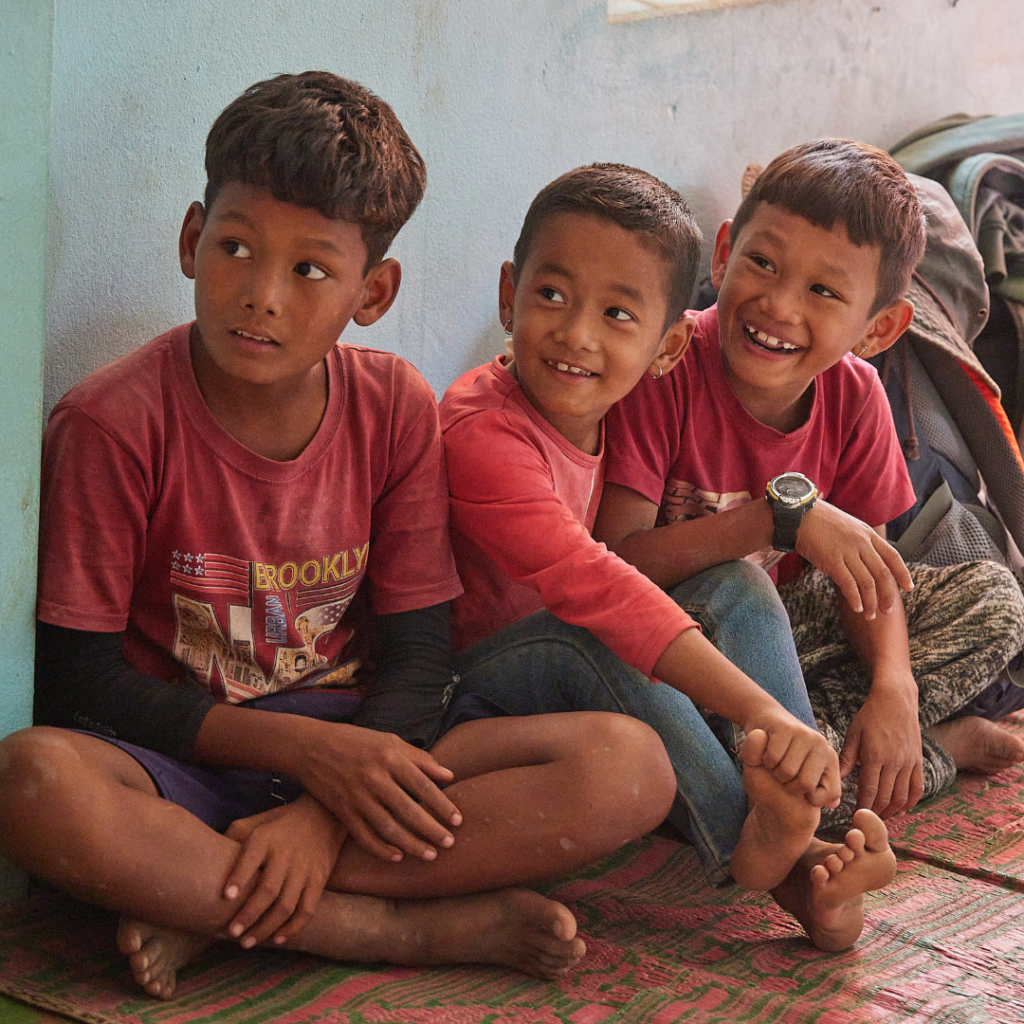
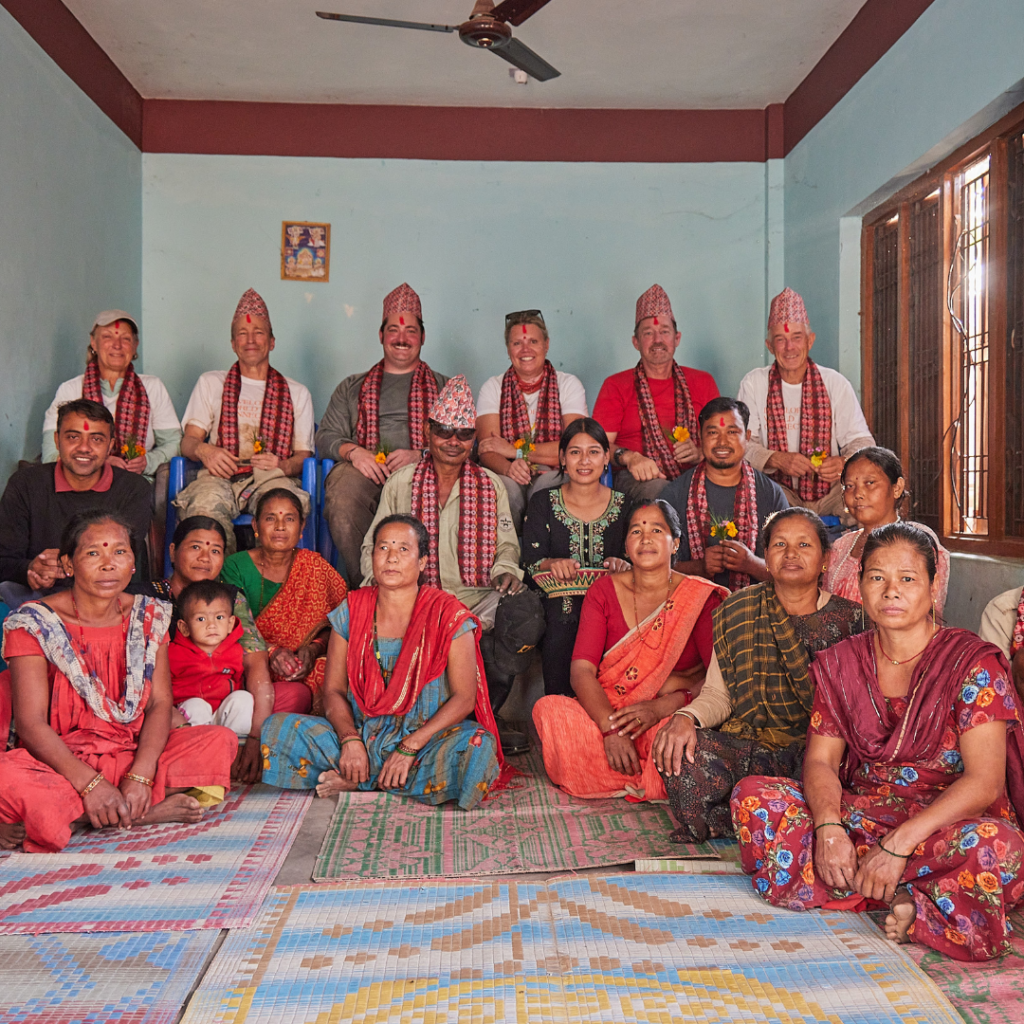
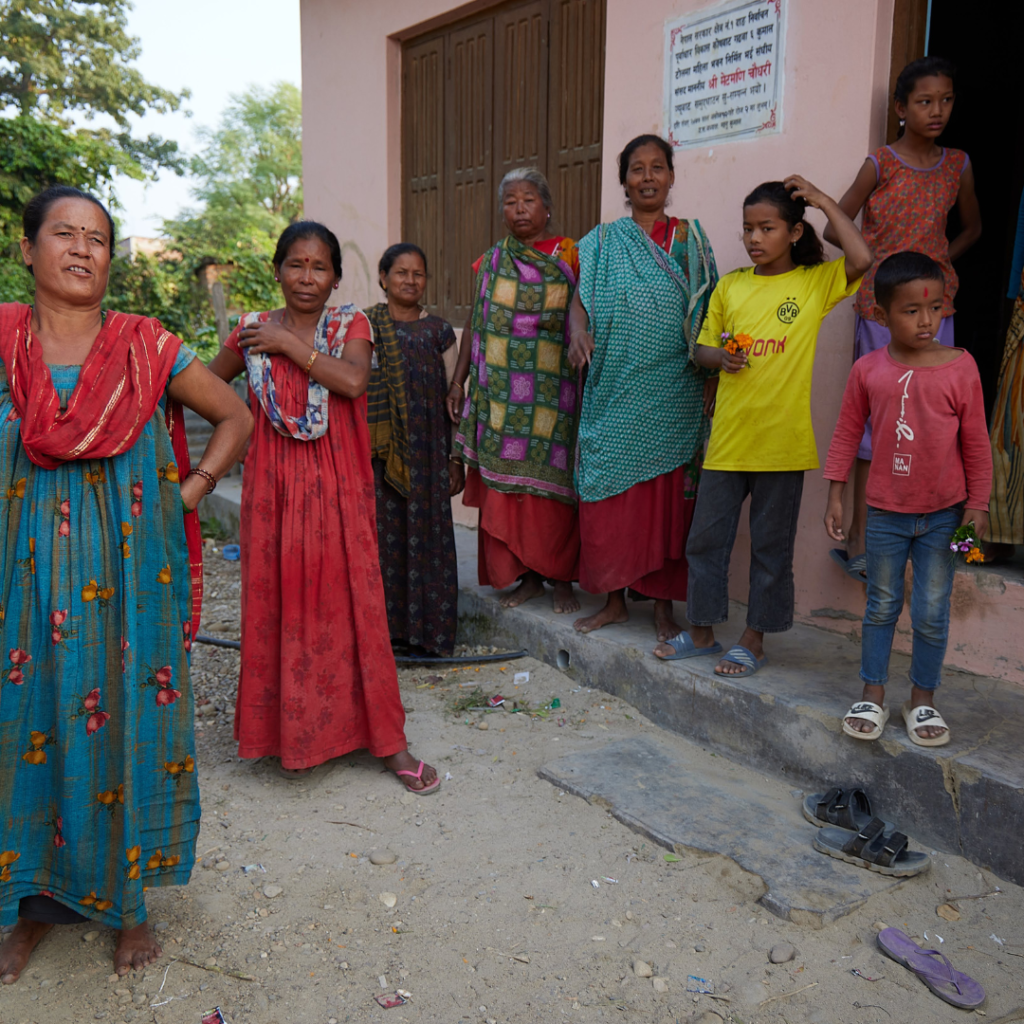
We were all blessed with Tikas and then just about everyone got a chance to speak. Several of the ladies were emotional and seemed truly moved and thankful for our help. We felt the same way with more than one of choking up a bit, thanking them for their warm welcome and how much we’d enjoyed working with them and for Sunita, her father, and the community. Sunita’s father was very moved and tearful when he thanked us through Dinesh’s translation.
Next, we took lots of photos and there were hugs and goodbyes all around. We finally left at about 4:30, taking our final tuk-tuk ride back to the Hotel Classic.
We were all very tired and went straight to our rooms to shower and prep for departure the next morning. Dinesh told us that several from Unako House would join us for dinner at 7:30.
I went to the roof to scrub my boots with a provided toothbrush and met Karen there who was washing a pair of pants in the rooftop faucet and basin along with cleaning her boots.
We met early for dinner–really a late happy hour. Soon, Shyam, Hemraj, Manoz, and one of tuk-tuk drivers joined us for dinner. Adam entered the hotel front doors and told us that he’d been downtown buying a gift for Dinesh, sking me to open a wrapped box. Inside was a bottle of Old Durbar ” Black Chimney” whisky, Dinesh’s favorite.
We immediately opened the bottle and Dharma arrived with whisky tumblers. Karen, Adam, Dinesh, and I a shot straight, while Kyle added his to his Coke.
Conversation moved to the project and we learned that the total cost of building the house for Sunita and her father was $7500 CAD. Adam and I wondered what kind of castle/mansion one could build here for $100,000 USD! Shyam told us that it probably wouldn’t be finished until mid- to late-December, something that didn’t surprise us given the pace of work likely after our departure. He promised to send us photos showing not only the completed house, but also progress shots. We learned that the roof would be corrugated, galvanized steel mounted steel stringers.
After dinner, we said goodbyes to the others, but Dinesh stayed with us. Kyle went to his room and remaining six played some cards. Dinesh explained the favorite Nepali gambling game (I didn’t catch the name) which amounted to a type of three-card stud poker.
We then taught him to play Golf and played a game of nine holes/hands. Karen won (again!) and then decided to call it a night.
Friday 10 November, 2023
I didn’t sleep well again due to my cold. Both of us were awake and up by 6 am. We’d intended to take on least morning shower, but the solar water heater’s product at that hour was barely tepid.
We finished packing (more or less) and went down to breakfast at 7:15. The evening before, we’d all settled our alcohol and laundry bills with Dharma, now he presented me with a 24,000 NRs refund for our three that had canceled. I would use as much of that as possible to pay for that evening’s final celebration dinner in Kathmandu because I didn’t want to have very many remaining Rupees to change before leaving the next morning.
I passed out 1000 NRs each to Joe, Karen, Adam, and Kyle to use for their final airport taxi on departure and wrote receipts for DWC, the. I passed the QR code to each team member so that they could complete their trip satisfaction survey. We would email one to Joe or he could do his at DWC when he returned to Kamloops.
Several of us brought down “leave behind” items to the lobby that Shyam would pick up later in the day, including work gloves and two pairs of boots.
Michelle joined us from Unako House and we loaded the three Mahindra Scorpios. Becky, Adam, and l loaded into the trailing vehicle for the two-and-a-half hour drive to the Gautama Buddha International Airport.
The ride was VERY rough. Our driver was very jerky, serving erratically, and seemed to be on the verge of either rear-ending the Scorpio ahead of us, or commiting to a head-on collision with and oncoming truck or bus while passing. I had to stop writing while we cleared the mountain pass that would take us into the Lumbini Valley. We’d intended to give him a tip, but he convinced otherwise. There were no seatbelts in the back seat, so Becky consoled each other saying that at least we had people in front to act as airbags and that this would be our last last South Asian highway drive of the long four week trip.
Air quality along the way, once we descended from the hills onto the plain near Lumbini, was even worse than in Lamahi–very smoky and no more than about 400 meters even in bright sunshine.
We arrived at airport and checked in. Dinesh brought me $156 USD that was a refund (minus ten percent) from canceled flights for those that couldn’t make the trip. We all also paid him 2000 NRs for our driver on 29 Oct. I used cash to buys snacks for lunch and we settled into the crowded, non-air conditioned outer terminal.
Dinesh told us that the flight was delayed by one hour–which prompted more snack purchases. At 12:45pm we went through security to the departure area which was even more crowded and hot than the main terminal. We watched one Buddha Air flight depart and then saw our airplane arrive. We boarded earlier than expected and we’re wheels up by 1:40 pm.
The flight was smooth and the plane completely full. Dinesh had reserved seats for us again on the Himalayan side of the plane and we had spectacular views of the peaks rising above the clouds.
We seemed to land early, boarded a bus that took us to the very crowded baggage claim and we were loaded and on our way to the CPN group home by 2:45 pm. I alerted the Hotel Thamel Park manager that we were on our way and would arrive by around 3:30.
We dropped Michelle at the group home and picked up Karen’s trekking gear, then took Karen to her hotel where she would meet up with her trekking group before meeting us for our celebration dinner at the Kathmandu Grill and Wine Bar near our hotel in Thamel.
Posted in Nepal on November 2, 2023



